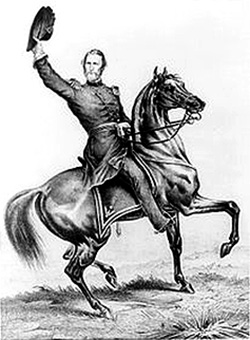
Please send all Checks and Money orders to :
Dave Taylor P.O. Box 87 Sylvania, OH 43560
419-842-1863
Click Here to E-mail Us!


13 05 second list

We note with great sadness the passing of Norm Flayderman.
It is truly the end of an era. Norm began his antique gun business before I was born, and he was active in it until the end … along with his lovely wife Ruthie and their new helper Victoria. His contributions to the world of antiques and antique arms are legendary and can never be duplicated.
He was a true gentleman. He was respectful and gracious. He will be missed by all. Good Bye Norm.

13-05-38 – 49th Pennsylvania Battle Diary and Folk Art carved Bone Ring: …
The ring belonged to Homer Smythe the diary was kept by his brother in law Joseph M. Rupp of the same regiment. Rupp enlisted in 1861 and served through October 1864. The 1864 diary measures 5 by 3 inches when closed and has green leather covers. Filled in every day through October … with clean concise entries. At the Wilderness and Spotsylvania he writes some stirring tales… starting on May 4th “…. Got up at 2 this morning marched three miles across the Rapidan. All very tyred. Very Tyred. Marched about 18 miles, all quiet in front.” 5/5 “Got up at daylight marched at 6. Left the Plank Road. Marched in line of battle about 5 miles in the Wilderness. Very heavy musketry… hard fite, heavy loss. 3rd Brigade took 400 Rebs, killed many.” 5/6 “Firing all night. Heavy firing on the front line in the front.
We are still held in reserve. drove the Rebs we got some artillery to bear on the enemy we run at dark for the plank road.” 5/7: “the troops fell back in the night on the right flank and fortified. not much fighting all day. we started with some sick men for the hospital. army moved to the left last night.” 5/8: “we were brought to help the 5th corps then built breast works all night. some shelling done through the day. heavy charge on our left. we was (in) a charge (on) the right til 12, moved to the left. General Sedgwick was killed. all skirmishing today heavy fighting in the front. General Sedgwick killed at the rifle pits” 5/9: “heavy cannonading all day from every side but no reply of any account. Our brigade charged and were drove back lost Colonel and Lt Colonel and 297 privates.” 5/11: “nothing going on but cannonading and skirmishing. Try to get our killed and wounded but could not. Was to charge but did not.” 5/12: “hardest day – the corps charged at daylight, took many prisoners, our brigade run in, four of my company killed dead. just terrible all day without any relief. Thousands killed. We had a very hard march.
5/31: “we lay quiet all day sharp shooters wounded 2 of our regiment johes was one. took up our line of march at 12 after the cavalry for cold harbor. marched all night. 2nd corps had some hard fighting today our left formed the line.” 6/1: “lay quiet until 12 today when the artillery opened and our line advanced a line. Hurt – captain wakefield that was broke off. 6 of company A hurt. regiment loss 28 – fighting continued until after dark, our side best.” 6/2: “regiment kept quiet today in front, but men lay low , sharpshooters kept them down. Fighting on the right heavy wave to charge but put off til morning. a good deal of picket firing all night.”
6/3 “charged at 4 this morning to the rebs works and held them. some fighting all day. The rebs tried to surprise our left after dark but were repulsed with heavy loss … a shell burned one of our ammunition wagons today.”
And at Winchester he writes … 9/19: “Reville 1 and a half pm, left camp 4, marched within 2 miles of Winchester went in line of battle. Very hard fighting captain Thompson wounded in 6 places and right arm taken off. general Russell killed. our men drove them out of the trenches…”
9/20: “yesterday at dusk the enemy was driven through Winchester – every man for himself running in every direction. This has been the greatest victory on record.”
The diary is chock full of super entries of the exploits of the 49th Pennsylvania in its hottest engagements. Also inside is a tintype of a woman and some period recipes.
THE CARVED RING …
From the same family comes this
Folk Art Sweetheart Ring
made in the Hospital after Spotsylvania! Very nicely carved finger ring made from animal bone with the top squared off and smoothed, scrimshawed with a heart pierced by an arrow then carved in and filled with colored wax or ink. Heart is red, arrow black, a few bits of the color gone. Accompanying this is a handwritten pencil note from the family reading, “Carving made from table bones- at Fortress Monroe- where H.S.S. was in hospital after injury at Spotsylvania court house (not done by H.S.S.)” along with a short typewritten label with tape stains reading, “Bone Ring: carved for Homer S. Smythe, at Point Lookout, Virginia in 1864, who was in hospital after injury at Spotsylvania. Made from table bones.” Homer S. Smythe was from Mifflin County, Pa., and enlisted in the 49th PA on 8/15/61 and was mustered into Co. E on the same day. He transferred to Co. D 1/11/63 and mustered out after three years service on 10/23/64. The Pennsylvania roster does not mention his wounding, but that roster is notoriously inaccurate. The 49th was a very hard-fighting unit that spent most of its service in the Sixth Corps, Army of the Potomac, and lost heavily, suffering 9 officers and 184 enlistedmen killed or mortally wounded during its service. Like many regiments in that corps, most of its losses occurred in Grant’s 1864 campaign and at Spottsylvania, where Homer Smythe was injured, the regiment took part in both famous assaults: on May 10 it lost 65 killed and many more wounded and missing. Two days later in the second assault it lost another 15 killed and still more wounded. By May 14 the regiment report says they had lost 392 men and could field only 130 for duty. That was a hard-hit unit! Smythe was lucky to have survived to muster out. He obviously acquired his sweetheart ring for his wife or girlfriend while convalescing- hence the family note that he himself did not actually carve it- probably trading for it from a fellow hospital mate or from one of the Confederate POWs taken during the campaign. A neat personal memento and showy piece of soldier folk art
…
Price for both 49th PV items
… $1,250.00 SOLD
Click Here to E-mail Us!
Call us @ 419-842-1863
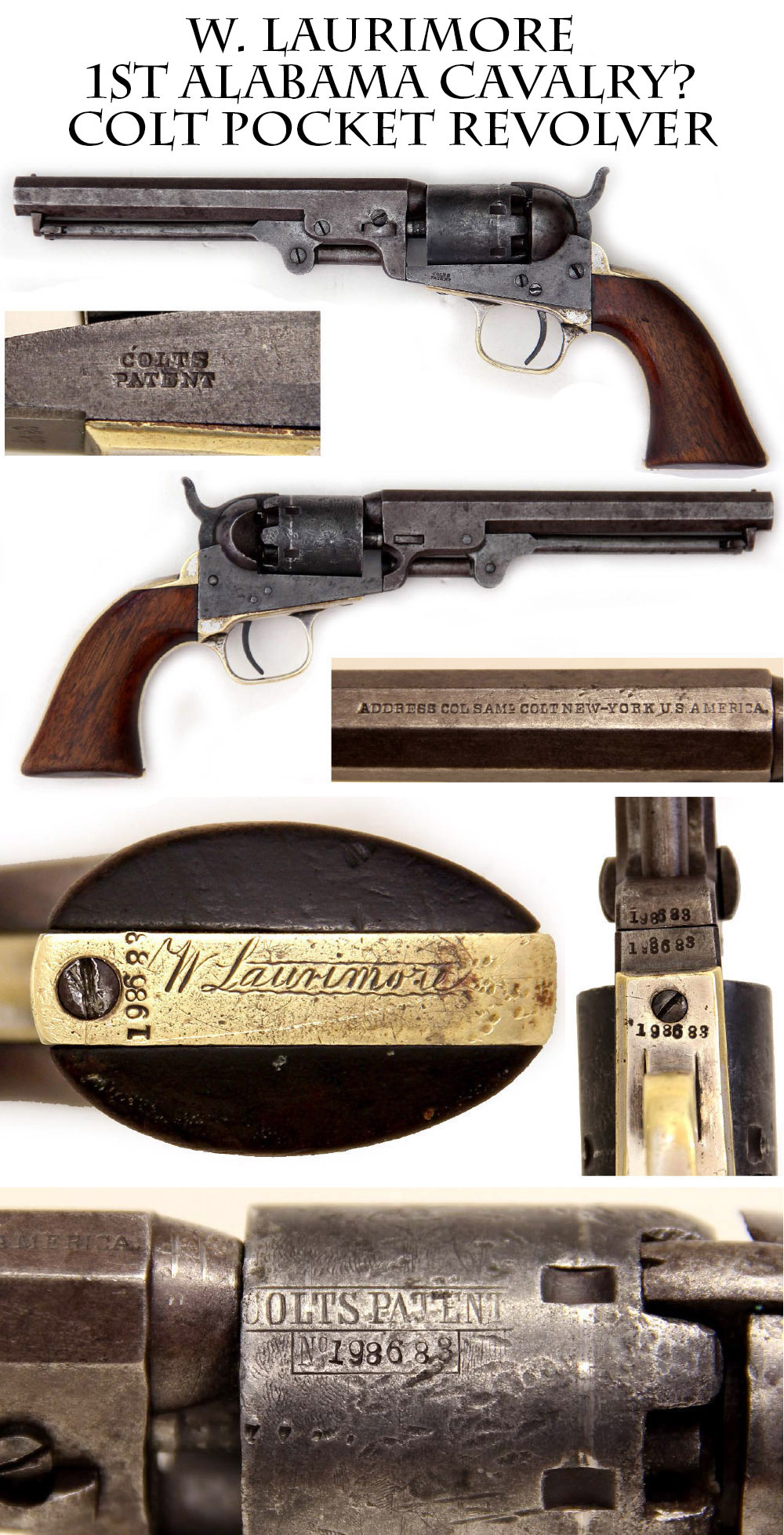
13-05-39 … 1862 Production Colt Pocket Revolver
likely carried in 1st Alabama Cavalry USA: This solid old Colt turned up at last month’s Michigan Antique Arms Show on Sunday morning. When I spotted it I asked if I could take it to my table to examine it carefully and the owner agreed. I returned to my tables to computer research the name engraved on the butt strap. “W. Laurimore”. After five minutes I was frustrated and was thinking I would not be able to pin down the owner. The data base on
CivilWarData.com
showed no soldiers in the Union or Confederate army named “W. Laurimore”. I then went to The National Park Service research page and found two soldiers listed with the name. Winner Laurimore 69th Ohio // and William Laurimore also spelled Lowrimore 1st Alabama Cavalry USA. Returning to CivilWarData I narrowed my search to the alternate spelling Lowrimore as shown by the National Park service and did indeed find two men in the 1st Alabama Cavalry named William Lowrimore… William G aged 30 and William P aged 18 … Cousins? … Uncle and nephew? The surname name is so rare the odds of two people not being related and serving in the same regiment are impossible to calculate. The last possible candidate, our boy Winner Laurimore of the 69th OVI is shown on
CivilWarData.com
as Winner Larimore, a 17 year old infantry private. In my opinion the sidearm is more likely one carried by a cavalryman and likely one of the Laurimores in the 1st Alabama Cav. USA. Perhaps archives research might tell more. The gun itself was manufactured in 1862. It is overall NRA very good condition and has the desirable six inch barrel. 100% original, 100% complete, mechanically perfect, and all matched serial numbers, good cylinder scene, and VG grips. The 1st Alabama Cavalry was made up of men from Ohio and also Union loyal Alabamians. It saw actions in Tennessee, Alabama, Georgia and Mississippi. They had over a hundred casualties at Vincents CrossRoads Mississippi. They were in 97 engagements and saw a lot of action. A solid old Colt with more research potential
… $1,475.00 SOLD
Click Here to E-mail Us!
Call us @ 419-842-1863

13-05-40 – Percussion Conversion Pomeroy 1835/40 musket.
When the percussion system was adopted in the US army, older flintlock arms in good condition and muskets like this one that were being delivered on the tail end of old contracts were earmarked for conversion at US arsenals by the Belgian or cone-in-barrel conversion. This is a nice example of the scarce Model 1835/40 manufactured by Pomeroy in 1844 and converted by the government rather than a private contractor. The Belgian conversion system was the only one used at the national armories and Pomeroys guns were fresh deliveries. Pomeroy supplied about 7,000 muskets between 1840 and 1846 following the pattern first proposed in 1835 and finally adopted in 1840. For the conversion the external flintlock parts were removed and holes filled, the brass flash pan ground off flush to the plate, a military percussion hammer added and the breech of the barrel tapped for a vent and nipple. Condition is very good being cleaned and burnished by the previous collector-owner. Lock has a clear 1844 over US behind the hammer and an eagle over L. Pomeroy in front. Very crisp butt plate and tang marks, with matching dates on the tang, as well as sharp barrel inspection and proof marks. There was a simple rear sight added at some time during its service. The wood rates very good++ with good edges and good fit, nice tone and very visible ink inspector cartouches on the offside as well. The wood was cleaned and oiled in by the previous collector. Sling swivels, barrel bands and springs, rod, bottom mounted bayonet stud, good mechanics. I see just the very lightest salt and peppering near the cone. This is a flashy example of the guns that were in arsenals at the beginning of the Civil War and typically saw hard service in the hands of the early volunteers. The previous burnishing makes the gun look very much as it looked when issued to the soldier in 1861
… $950.00 SOLD
Click Here to E-mail Us!
Call us @ 419-842-1863

13-05-41 – Darn Near MINT Enfield Artillery Carbine!
If you want to know what one of these looked like out of the crate, and have bragging rights to owning one, this is your chance. This is the 1853 Second Pattern Artillery Carbine, sometimes also termed the 1858 Pattern, having some improvements from the 1853, including different rifling, more robust barrel bands and hammer, and a rear sight of one fixed block and two folding leaves. Very clearly marked Barnett/ London on the lock plate, and Barnett/ Gunmakers/ London in a wonderfully sharp wood stamp in the butt stock. The Barnett London mark on the lock is the sans serif font which is in contrast to the more common marking with serifs on the lettering. In my research on this carbine I found an identical one used by Indians on the western frontier with the same lock marking. This is the so-called non-ordnance pattern, made without the bayonet lug, otherwise the standard artillery pattern. Ramrod, brass nose cap, sling swivels on front band and belly of stock all in place. Crisp mechanics. Good proof and inspector cartouches on left of barrel, forward lockplate, and in wood opposite lock and behind the triggerguard tang. But look at those sharp edges to the wood and that color! This retains 95% armory blue and 70% armory case color with just a little surface rust on the lock. Nice deep tones to the wood, beautiful blue on the barrel and bolster. Sharp wood around the lock and tight wood to metal fit. The hammer and lockplate show a little mottling, with plum and brown spots rising through the case and blue. Perfect nipple. I dont think this thing ever had a round put through it. Unused, untouched, unmessed with and priced realistically
… $2,250.00 SOLD
Click Here to E-mail Us!
Call us @ 419-842-1863

13-05-42 – Very Scarce Merrill Breech Loading Infantry Rifle.
James H. Merrill of Baltimore made about 14,000 of his famous carbines, but only 800 of these two band infantry rifles of which 770 were bought by the US government. The only regiment issued these as a unit seems to have been the 21st Indiana, but a number were parceled out to other regiments including the 7th Michigan and 1st Massachusetts for use by sharpshooters. They are a scarce and highly sought-after rifle. These are very handsome with all the brass furniture… Brass butt plates, brass barrel bands, brass nose cap, side plate, and patchbox. The loading mechanism is the same as the carbine: a lever at the breech lifts up and pulls a plunger to the rear, allowing the solder to quickly load a .54 caliber cartridge, which he plunges forward – a percussion cap is then placed on the nipple and he is ready to go. The main fault is that the Merrill mechanism weakened the wrist and many show cracks in the wrist as this one does. This one has a very well repaired horizontal crack running back from the rear of the lock back through the wrist. The repair is solid. Stamped US on the buttplate tang, matching assembly numbers on the mounts, and serial number 14180 on assembly. Sharp 1863 date to rear of lockplate, eagle and Merrill patent information forward of hammer, just a tad light in the upper lines. All screw slots good. Buttplate tang screw a little rough, others nicely rounded. Correct rod, swivels, saber bayonet lug etc… 100% original except for a proper custom made replaced rear sight with leaves. Barrel shows a dusting of salt and pepper firing corrosion near the nipple, but the “J.H. Merrill Balto / Pat. July 1858” barrel stamp is very legible and the metal smoothes out to a faded steel mixed with gray. Mechanism very good. Very pleasing mellow brass and nice wood tones. A nice looking example of a very scarce and desirable Civil War breech loading rifle
… $2,650.00 SOLD
Click Here to E-mail Us!
Call us @ 419-842-1863

13-05-43A – Model 1841 Mississippi Rifle w/ Bayonet Lug Alteration:
A very handsome example and very affordable as the stock has been restored (stretched as we say). This 1853 dated Whitney contract is overall VG with the exception of the added wood of course. The front of the stock was replaced from behind the lower barrel band forward. I would judge that this replacement was necessitated due to wood damage as opposed to the rifle being sporterized. The bands, conversion lug, etc are all original and would not have been retained if the gun were sporterized. All metal markings are clear except the date on the barrel tang. Mechanically perfect. Serial number 4871 on barrel behind lug. Good bore. Has replaced civilian style rear sight. Brass tipped ram rod is proper but may be a newer replacement judging from the condition of the rod.
A most affordable Mississippi
… $1,195.00
SOLD
13-05-43B –
Bayonet for above with scabbard as shown
… $325.00 SOLD
Click Here to E-mail Us!
Call us @ 419-842-1863

13-05-44 – Ames 1840 Pattern Light Artillery Saber.
A horseman needs a saber and these brass D-guard sabers were worn by artillerymen required to be mounted: drivers and some others in the light artillery, and everyone in the horse artillery batteries. They are the counterparts to the 1840 dragoon sabers, and were kept in service throughout the Civil War. This one is dated 1865 on one side of the ricasso with a US and an ADK inspector mark, and on the other with the Made by Ames Mfg Co. Chicopee Mass. stamp. Markings lightly rubbed top and bottom edges, but clearly legible. Original leather and brass wire wrap to the grip and even the original leather pad meant to seal the scabbard throat when sheathed (the first patterns had no collar on the scabbard, only a recess in the guard.) Very mellow undisturbed patina to the brass guard and pommel. Correct J.C.W. inspector stamp on the knucklebow. Patina is dull silver mixed with gray areas overall. Scabbard is likewise V.G. with throat, drag and both carrying rings. Some very light crustiness here and there. A couple of thin seam openings along the brazed edge. A decent example of a regulation Civil War saber that would go well in an edged weapons or artillery display and wont break the bank
… $795.00
Click Here to E-mail Us!
Call us @ 419-842-1863
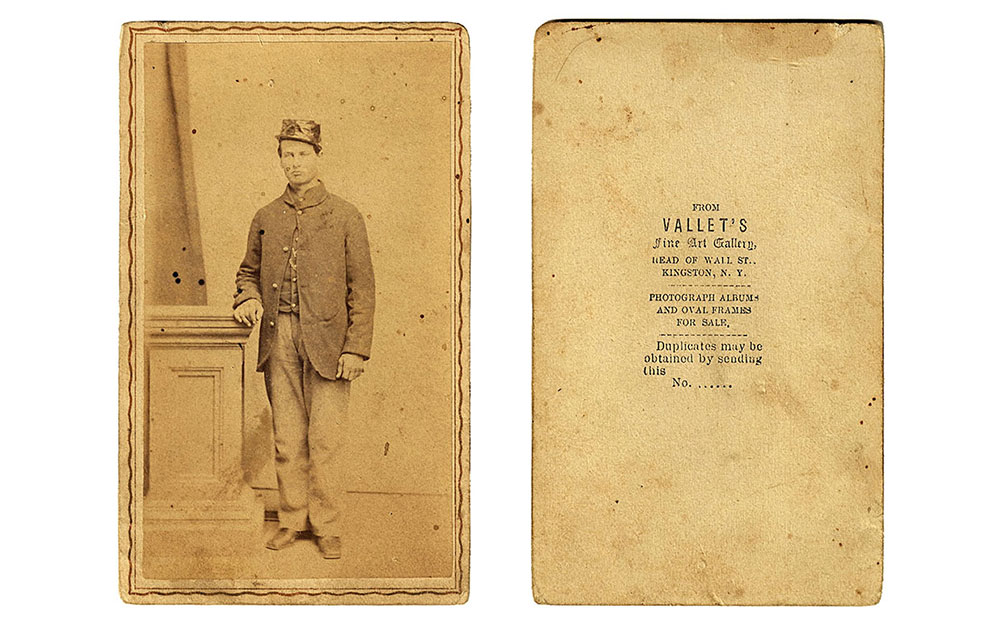
13-05-45 – CDV Nice full-standing view of a typical Billy Yank
sporting a rain cover on his forage cap and a regulation sack coat. Vallets of Kingston, NY, backmark. Nice sepia tone, a few spots not affecting the subject. Posed one hand on a short column, his sack coat open to show a military vest, regulation trousers and those square-toed shoes wed like to find in a soldiers effects. No tax stamp, so we are looking at a good early-to-midwar soldier
… $35.00 SOLD
Click Here to E-mail Us!
Call us @ 419-842-1863
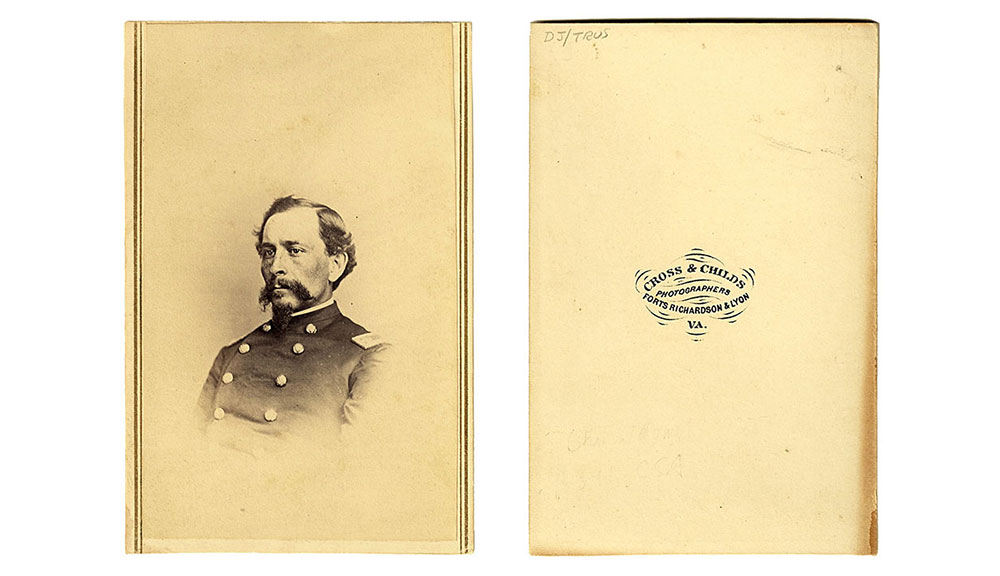
13-05-46 – CDV Dashing and somewhat thoughtful field officer.
Vignette chest-up view of a mustachioed major or lieutenant-colonel from his double-breasted coat and oak-leaf straps. Cross and Childs, Forts Richardson & Lyon, Va., backmark, so taken on the outskirts of Washington. He wears a thoughtful, almost sad, expression. He looks familiar and it might be possible to identify him as his rank is high enough that his portrait may have been published in a unit history. I leave that research project for the next owner
… $35.00 SOLD
Click Here to E-mail Us!
Call us @ 419-842-1863
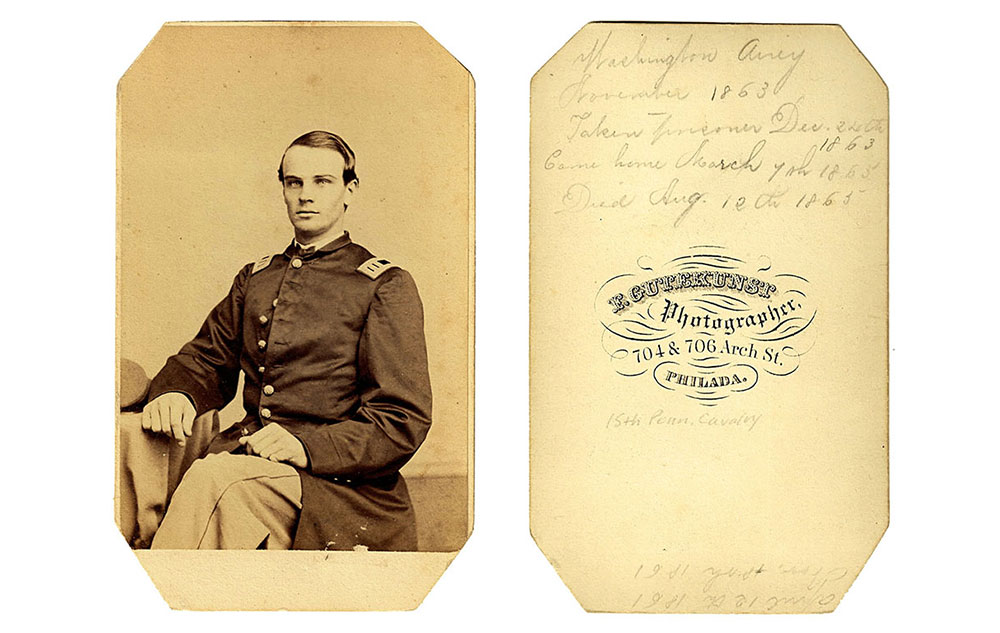
13-05-47 – CDV Photo Captain Washington Airey, 15th Pennsylvania Cavalry,
a Gallant and Exemplary Officer Captured at Tullahoma: released only to die a lingering death from disease contracted during fourteen months in southern prisons! Very strong, three-quarter seated view of a handsome young captain seated with arm resting on a table. His forage cap partly visible to the left. Officers frock partly unbuttoned, nice large captains shoulder straps. Light trousers. Corners clipped for album insertion, but not affecting the subject. Some teeny specks of wear to the lower edge of the albumen. Gutekunst, Philadelphia backmark (arguably Philadelphias BEST war time photographer). Period pencil id on reverse: Washington Airey / November 1863 / Taken prisoner Dec. 24th 1863 / Came home March 7th 1865/ Died Aug. 12th 1865. Modern collector pencil note at bottom identifying regiment as 15th Penn. Cavalry. The phrasing of the period pencil inscription certainly implies he died as a result of his captivity and the regimental history and PA at Chickamauga and Chattanooga bears this out. Washington Airey resided in Philadelphia and was 19 when he enlisted on 4/25/61 as a private in Co. F, 17th PA Infantry, a short term unit, and mustered out 8/2/61. A year later he again entered the army, mustering in to Co. C of the 15th PA Cavalry and made Sergeant on 10/31/62. He must have been well thought of because he made regimental Sergeant Major just a week later, 11/7/62, and then Captain of Company L 3/1/63. The 15th was a three-year regiment nicknamed the Anderson Cavalry and prided itself on having picked-men in its ranks from influential families in the state. A detachment was actually called into the field during the Antietam campaign while the regiment was still organizing. They eventually were sent to the western theatre and saw action in Tennessee in the Nashville area, the Stones River campaign, the Chickamauga campaign, Seviersville, and other locations. In June, 1863, Airey commanded a squadron of two companies at Murphreesboro called upon to deliver dispatches to Gen. Mitchell. In the course of the mission he engaged in two charges against Confederates blocking his way. In December, 1863, they were scouting the left flank of Longstreets forces moving back toward Virginia, skirmishing with Confederate cavalry and gathering prisoners and intelligence. At Dandridge they got into a heavy fight and lost 75 men killed, wounded and prisoner, among them Captain Airey, who was confined at Macon and Columbia: On the 24th, the regiment participated in the battle of Dandridge, which was fought by the brigades of Sturgis and Elliott. After a sharp skirmish the enemy was driven, and in full retreat, but was timely reinforced by a brigade from Morristown, and was thus enabled to make a stand, before which the Union force was obliged to retire. In the fight a spirited dash was made by Colonel Paler, with ninety of his men, before whom the enemy fled in confusion but returning, he was fired on by a party in concealment, and ten of his men were dismounted and fell into the hands of the foe. Captain Washingtonn Airey was among these, and for fourteen months endured the hardships and privations of imprisonment, being finally released to die of disease contracted thereby. Airey is mentioned several times in the regimental history and his archive records should prove interesting. His fate was tragic and not uncommon for those subjected to Civil War prison experience.
One of the more interesting wartime photos Ive come upon recently
… $250.00 SOLD
Click Here to E-mail Us!
Call us @ 419-842-1863
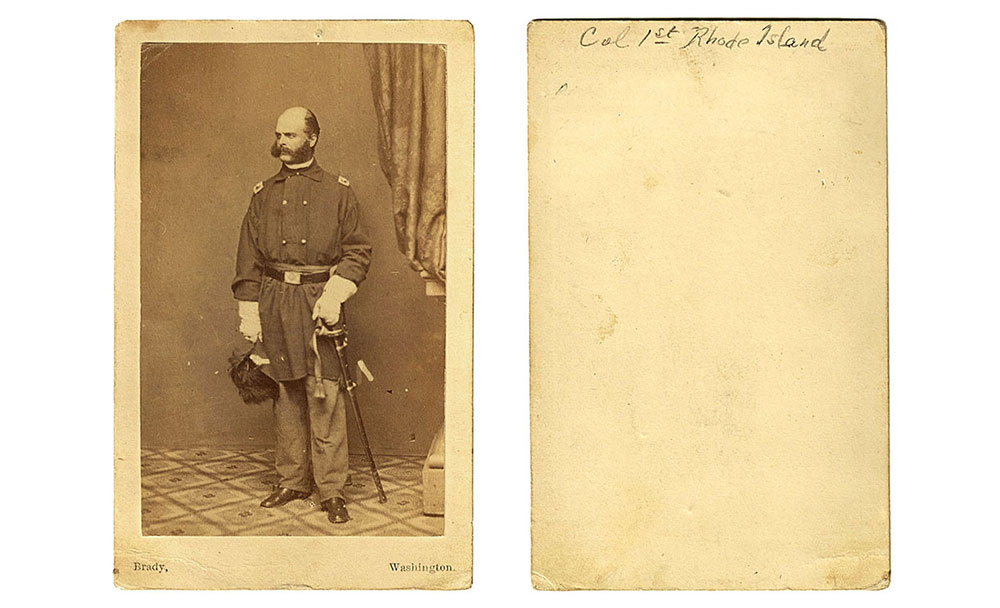
13-05-48 – Very Rare CDV From life view of Ambrose Burnside as Colonel of the First Rhode Island,
by Brady, Washington. Nice full length standing view of the famous officer. Incredibly hard to find photos of him when he was a young Colonel. He wears his trademark side-burns, the Rhode Island or Burnside blouse familiar to uniform buffs, with colonel shoulder straps, an officers sash and belt, grasping the hilt of his sword with one guantleted hand and his officers hat with the other. A pretty dynamic portrait. West Point class of 1847, Mexican War and service against the Apache, later businessman, congressman and postwar a senator. Recruited the First Rhode Island, led a brigade at First Bull Run, and a successful coastal expedition in the Carolinas, at which point he had apparently risen to the level of his incompetence and dithered as a major general at Antietam and nearly ruined the Army of the Potomac at Fredericksburg. Slightly more successful in the west, he came back east to repeat his mediocre performance as commander of the Ninth Corps in 1864 campaign. Associated with the facial hairstyle of sideburns, the low crown officers Burnside hat, the Burnside blouse, the Burnside carbine, associated with just about everything but victory. A significant Civil War figure in a very nice early war shot from life by the most famous Civil War photographer.
Extremely scarce image and wonderful showing the rare Rhode Island Blouse
… $250.00 SOLD
Click Here to E-mail Us!
Call us @ 419-842-1863
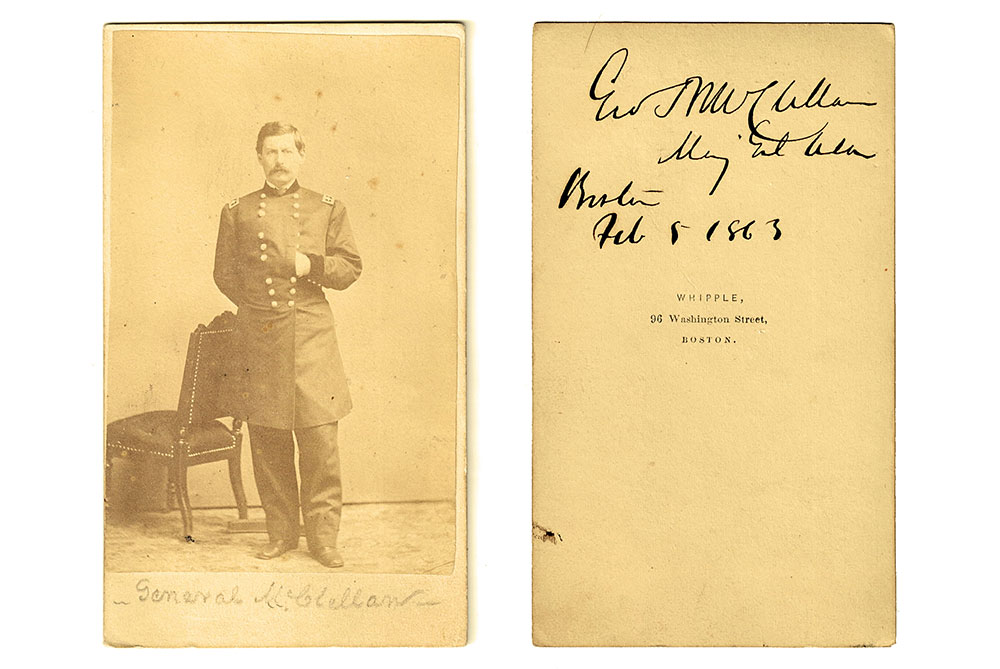
13-05-49 – Autographed Gen. McClellan CDV by Whipple of Boston.
Full standing view of George Brinton McClellan in uniform in his Napoleonic pose, one hand inside his lapel the other behind his back. Standing next to a chair. Whipple, Boston, backmark, period pencil id at bottom front, signed by Little Mac himself in ink on reverse: Geo B McClellan / Maj Genl USA / Boston / Feb 5 1863. Taken not long after his removal from command of the Army of the Potomac in November, 1862, and while still awaiting orders for his next assignment that never came. West Point class of 1846, favorably mentioned in Mexico, an Engineer by training and disposition, he was well-loved by the Army of the Potomac, had some important early successes, but was far more attuned to planning, organization, and preparation than dynamic action. Ran against Lincoln in 1864, later governor of New Jersey. Nice view, a tad light, minor spots not affecting the figure. A scarce signed photograph of one of the most important and controversial generals of the war.
Priced at a fraction of the west coast autograph dealers
… $750.00
Click Here to E-mail Us!
Call us @ 419-842-1863
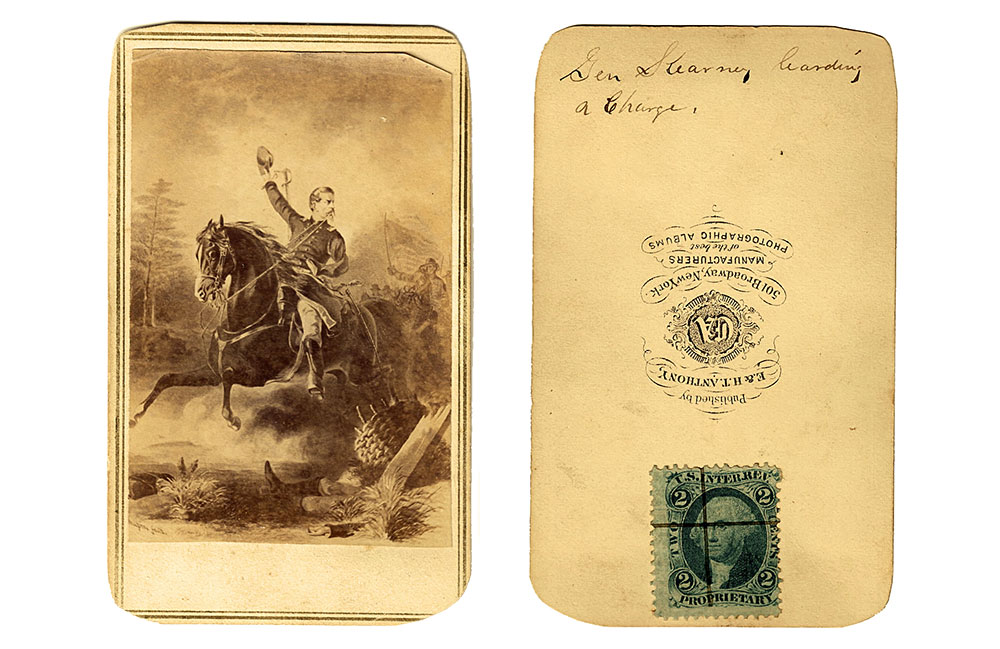
13-05-50 – CDV “Gen Kearney leading a Charge”
is the period ink inscription on the back of this CDV by E. & H.T. Anthony of portrait of the one-armed Kearney waving his cap and holding his reins in his teeth as he gallops forward ahead of his troops. Photographic copy of an engraved scene. Kearney was a wealthy soldier of fortune who lost an arm in Mexico, served for a while in the French army, and then earned a good combat record in the Civil War as a brigade and division commander. Killed at Chantilly in 1862, Kearney was called by Winfield Scott, “the bravest man I ever knew, and a perfect soldier.” It is significant that this card has a cancelled tax stamp. That means that it was not purchased until two years after Kearney’s death, indicating that he was still a very well regarded general and famous commander. Corners rounded for album insertion. Upper right corner of albumen cut. It is not too much to suppose one of his devoted veterans may have been the purchaser. A most affordable historic CDV
… $45.00 SOLD
Click Here to E-mail Us!
Call us @ 419-842-1863

13-05-51 – CDV General Hugh Judson Kilpatrick, old Kill-Cavalry.
Fredericks photographer backmark, paper residue on reverse from a mount with Fredericks in old ink. Card trimmed across top and bottom to edges of albumen. Half-length seated view with part of his hat visible on his lap, and wearing a brigadier generals frock coat with a single star sews to the shoulder without shoulder strap. Kilpatrick was West Point class of 1861, briefly served in the infantry and then as field officer in the Second NY Cavalry. Made general at the same time as Custer, and although successful was known for a cavalier disregard not only for danger, but often for the welfare of his own men and nicknamed Kill-Cavalry by some. Involved in numerous raids and expeditions, blamed for launching Farnsworths ill-fated charge at Gettysburg and the Dahlgren raid on Richmond, Sherman supposedly said he knew Kilpatrick was a hell of a damned fool, but needed just such a man for his own cavalry and brought him west to fend off Wheeler and lead his own mounted troops on the March to the Sea. Apparently he liked both fast horses and fast women- his amorous escapades were the subject of much comment as well. After the war he left the army and served as an ambassador in South America. A rather knowing and self-confident portrait of one of the wars more controversial and dynamic figures.
A crisp and exciting from-life portrait
… $75.00 SOLD
Click Here to E-mail Us!
Call us @ 419-842-1863

13-05-52 – Full standing retouched CDV portrait of Ellsworth.
Elmer Ellsworth posed in front of a military camp, wearing his uniform and cap, partially leaning on his sword. A pre-war friend of Lincoln in Illinois, Ellsworth helped ignite the craze for zouave uniforms and tactics among militia companies in the late 1850s by organizing a national tour for his United States Zouave Cadets out of Chicago. He was given the colonelcy of the 11th New York at the beginning of the war, the regiment prided themselves on recruiting from the best and bravest firemen of New York. They were the Fire Zouaves … brave and noble. Ellsworth earned his spot in history when Federal troops moved into Virginia, occupying Alexandria, and he raced to the roof of The Marshall House hotel that still flew a Confederate flag. He tore down the flag and was met on the way downstairs by the proprietor of the hotel who murdered Ellsworth with a shotgun blast. The murderer was immediately bayonetted to death by Ellsworths avenger … fellow zouave Francis Brownell. Ellsworth was at once the martyr for the Union.
A nice early war card
… $65.00 SOLD
Click Here to E-mail Us!
Call us @ 419-842-1863

13-05-53 – CDV A sober and responsible field officer: Mark Hollingshead, Additional Paymaster, US Volunteers.
The identification transferred from an album page to the reverse of the card in pencil by a collector and I have seen another carte of him signed in ink. Trimmed at corners for album insertion, cancelled tax stamp on reverse. Vignette bust shot shows the bearded officer in his double-breasted field grade officers frock. Hollingshead served from 23 February 1864 to 30 April 1866. Men joined the army for many reasons, but none was oblivious of army pay. Officers had to pay for their own uniforms and day to day needs, enlisted men might be supporting a destitute family at home. They might be mustered for pay every two months, but all anxiously awaited the actual visit of the paymaster. Entrusted with hundreds of thousands of dollars, these officers had to be sober,
dedicated and precise
… $75.00
Click Here to E-mail Us!
Call us @ 419-842-1863

13-05-54 – CDV Little Mac …
Early war unmarked CDV engraving of the famous general McClellan in his Major-Generals frock. Undoubtedly made to cash in on the generals early war fame. A vignette bust view, he looks off to the viewers right. If he had been as good a combat combat commander as model for artists and photographers the war would have ended a lot sooner. Nice example for a display of the patriotic material produced in 1861-1862 for a hungry public. Minor pinhole bottom edge, otherwise nice
… $25.00 SOLD
Click Here to E-mail Us!
Call us @ 419-842-1863
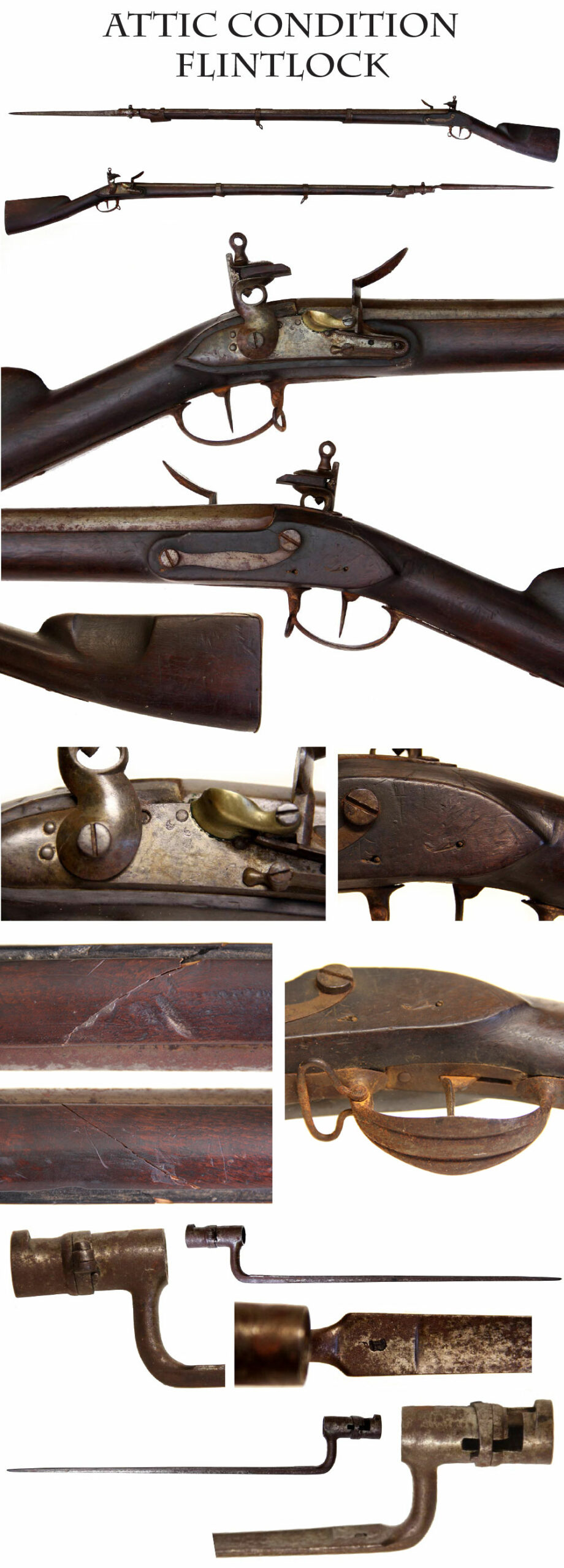
13-05-55 – Napoleonic Era Untouched attic found flintlock musket with bayonet.
Appears to be an unmarked M1777 Charleville musket. This just turned up at a local auction and was completely misdescribed. It had a crack in the forend which I had helper Tom glue back together … Otherwise untouched and as found. The crack was caused by warping over centuries in an area of the stock where there was a slight twist in the grain. It is an age crack … it was not damaged through mishandling. Specs … Iron mounted flintlock, 40 inch barrel, 54.5 inches overall, brass flash pan, completely functional, all bands and swivels in place, no rod present, but it could be replaced, no identifying markings, just some small marks on the lock behind the pan and a sunken cartouche on the bayonet I cant make out. Long narrow wrist and high delicate comb on the butt stock are carryovers from the 18th century. The rounded pan and reinforced hammer are early 19th century features. Recessed cheek rest on the left, reinforced style hammer, Comes with a socket bayonet that has a locking ring. The trigger guard is somewhat light in weight compared to other similar muskets we have owned. The musket is certainly western European 1810 to 1830s. I cannot tell if it is French, Belgian, or a brevet copy of the Charleville??? Bayonet may be somewhat later, has 16 inch blade and 2.75 inch socket. Metal a dull gray with brown spots rising from underneath, generally smooth. Wood dark with good edges, minor dings and scratches. Totally appropriate for a Napoleonic display, or War of 1812 … not totally out of place for Rev War either.
A great old REAL flintlock
… $1,450.00 SOLD
Click Here to E-mail Us!
Call us @ 419-842-1863

13-05-56 – A Remington Navy Navy Revolver.
Remington made about 28,000 of these .36 caliber new model navy revolvers and like the armies, they gave Colt a real run for his money with their rugged construction. This one shows the ravages of a long and hard life. It is in fair to good condition with decent grips and mechanics, but has a crudely repaired upper frame and lacks the rammer assembly, which could be scrounged from another gun, but I leave that to the next owner. This one is serial number 24,124, and is set apart from most by the dead real small anchor stamped on the barrel, marking it as a real US Navy purchase, the majority of these guns being either non-military, non-naval, or not marked. Overall gray metal, some bright mixed with a dull pewter tones, some dings to the barrel and cylinder, assembly marks and serial number visible, barrel markings only partly legible, as is usually case with genuine naval issue arms that were constantly polished against the ravages of a salt-water environment. Needs some work, but is a scarce side arm for the Civil War navy and US martial pistol collector.
The grips are worth half the price of admission
… $495.00 SOLD
Click Here to E-mail Us!
Call us @ 419-842-1863

13-05-57 – Fine Condition Wild West Indian Fighter – Remington New Model Army Cartridge Conversion Revolver.
NRA near fine condition with 80%+ blue finish intact. This Remington was converted for use with metallic cartridges immediately following the Civil War. This one still shows the Civil War military inspector cartouche on the bottom of the grip and a few conversion batch numbers of 47 stamped in the brass triggerguard, under the barrel and maybe elsewhere. The original percussion serial number 83201 is still present on the underside of the barrel near the large 47. The conversion is the style done without the addition of an ejector rod. Grips about excellent, no dings, tight fit, cartouche, extra nice. Metal fine+ barrel markings clear, just a tad light at the bottom. When found this had a hammer with a broken spur. I had helper Tom replace it using an original percussion hammer. I include the conversion hammer with this. About 200 times rarer than the standard percussion examples and still darn affordable
… $1,595.00
Click Here to E-mail Us!
Call us @ 419-842-1863

13-05-58 – 1859 DATED HARPERS FERRY 1855 PATTERN RIFLE-MUSKET with PATCH BOX!
NRA very good condition. 100% original. 100% complete. Mechanically perfect. It was these late-dated 1855 pattern rifle muskets that were still at the Harpers Ferry Armory in Virginia when it was seized by Confederate forces in 1861 and the existing inventory and machinery carted off to arm the south. So this may have seen service in Confederate hands. This is an ultra desirable pattern by any standards. Far rarer than Confederate Richmond muskets, and rarer than the Fayetteville rifles. 1855 muskets made at Springfield are very, very desirable ones made at Harpers Ferry are in a class all by themselves. The 1855 series of arms was the first to employ the uniform .58 caliber which was standard through the end of the Civil War. Both the short rifle and the long rifle-musket were the new .58 cal and incorporated the new Maynard primer system which never worked as well as first hoped. This one is in very good condition for a Harpers Ferry. Crisp visible 1859 and U.S. Harpers Ferry marks on the lock plate, good eagle on the primer compartment door, legible VP Eagle barrel proofs and an 1859 barrel date are likewise visible without too much effort. Some corrosion from firing at the breech. Also visible are the Harpers Ferry inspector cartouches in the stock opposite the lock. Iron patch box in the butt stock. Has 1862 style rear sight showing that it was still in service during the war and had the sight replaced. Rack or assembly numbers visible on some parts. Very Good wood, with only expected light wear. Decent nipple not battered down, barrel faded grey. Aside from the 1862 rear sight this musket is 100% Harpers Ferry from muzzle to butt plate. I cannot stress enough how rare finding a Harpers Ferry patchbox 55 rifle musket is. Perfect for early war US or CSA display
… $3,600.00 SOLD
Click Here to E-mail Us!
Call us @ 419-842-1863

13-05-59 – US 1850 Pattern Staff and Field Officers Sword with Scabbard.
This is the regulation 1850 pattern officers sword incorporating the U.S. in the guard design and intended for officers of staff and those ranking Major and above. Since these officers were mounted, their swords were to have sturdier metal scabbards. The blade on this is VG++. Has lovely etching of the standard vines and scrolls mixed with a US on one side and a nice spread winged eagle on the other holding a ribband inscribed E Pluribus Unum in its beak. The blade has some scattered gray spots. Sharkskin and wire grip is tight and complete Brass guard, pommel and knucklebow show a mellow patina. Leather bumper pad in place below guard. The sword is unsigned by maker. The scabbard is likewise VG to near fine with just a couple bumps near the drag. Very handsome. Scabbard metal is smooth overall, brown faded to an even plum brown.
A very solid and affordable example of this desirable sword
… $1,550.00 SOLD
Click Here to E-mail Us!
Call us @ 419-842-1863

13-05-60 – Indian War M-1868 Springfield Trapdoor Rifle:
The forerunner of the famous 45/70 trapdoor is this 50 caliber rifle made at Springfield utilizing surplus Civil War musket parts and new made rifle parts. Slightly more than 50,000 were produced, and they saw service on the western frontier. This one is NRA very good+++ condition. 100% original. 100% complete. Mechanically perfect. For kicks I have included a photo of an Indian Warrior carrying one of these old war horses. Great old Springfield and darn affordable
… $850.00 SOLD
Click Here to E-mail Us!
Call us @ 419-842-1863
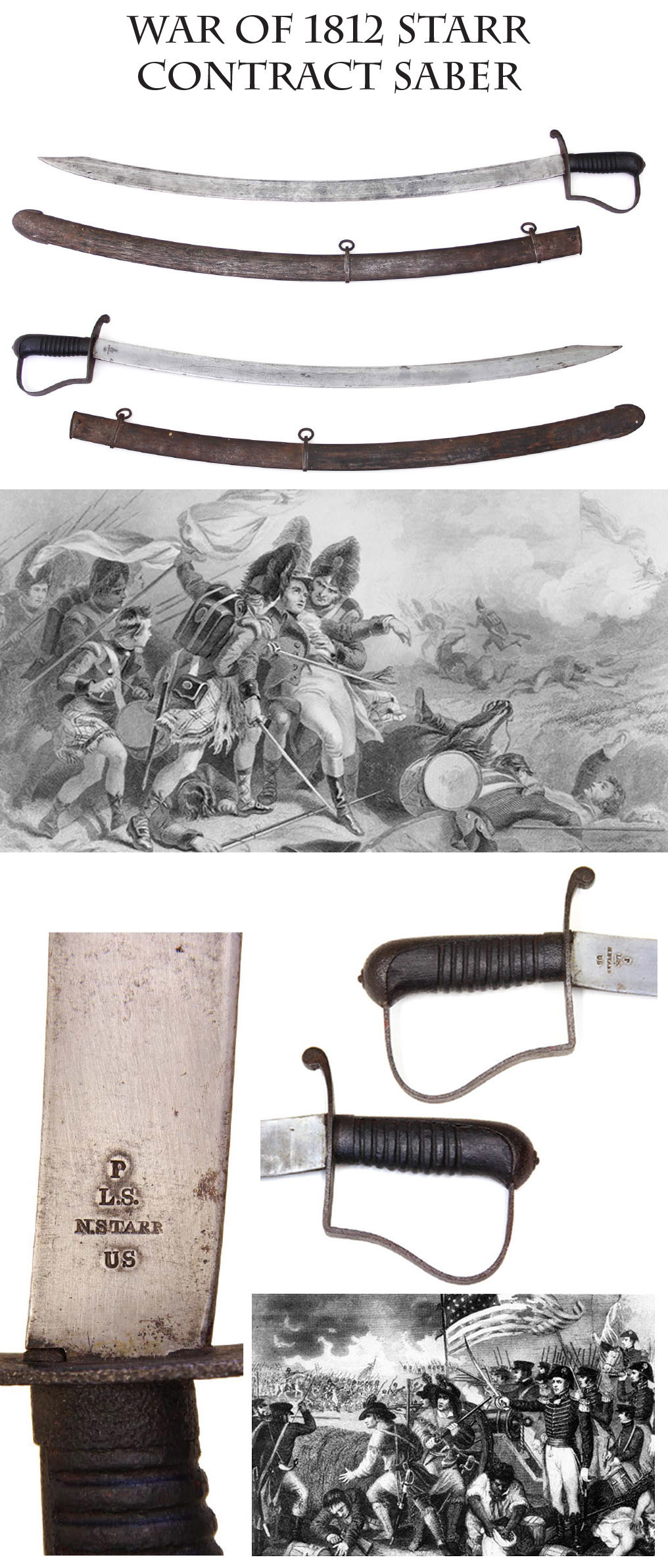
13-05-61 – 1812/1813 Pattern Starr contract dragoon saber and scabbard.
Starr is one of the most famous early American arms makers. This is one of his War of 1812 period sabers produced on contract for the US government from the beginning of 1813 through 1817, sometimes called the 1813 pattern and differing from the 1812 in the size of the guard and iron scabbard, and from the 1818 in its flat, unfullered blade. This one has a nice smooth blade, no nicks, sharp markings: P/L.S./N.Starr/US near the guard indicating government inspection by Luther Sage, generally bright overall, mellow gray, but not dark. Very good wood grip, a light corrosion speckling on the iron guard and pommel, but not bad. Iron scabbard with carrying rings in place, very solid, brown mixing with gray. A nice example of a key weapon in the development of US edged weapons and regulation cavalry arms, carried in the very early Indian Campaigns and westward expansion, and still serviceable at the opening of the Civil War. Many were carried by Confederates.
Nearly 200 years old and still priced the same as a common 1860 Cavalry saber
… $895.00
Click Here to E-mail Us!
Call us @ 419-842-1863
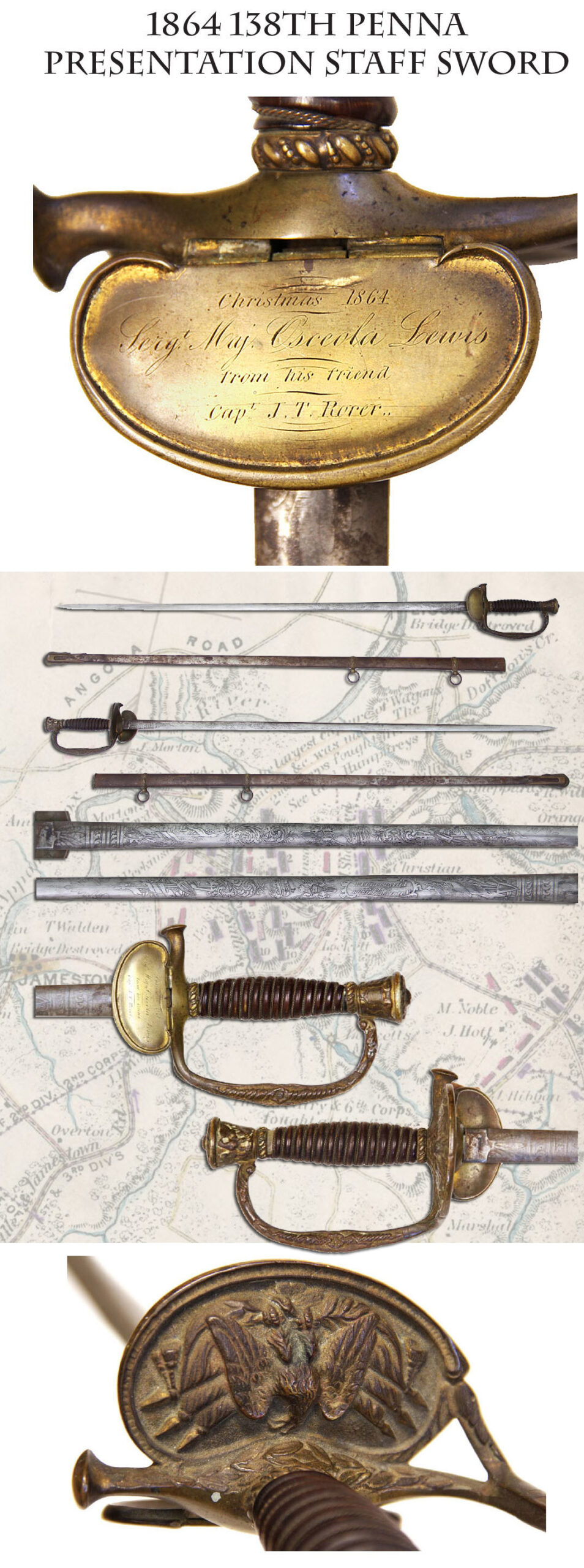
13-05-62 – Exceedingly Scarce War Date 138th Pennsylvania Vols. Presentation 1860 Pattern Staff and Field Sword.
Finding a Pattern 1860 Staff sword actually made during the Civil War is a rare rare event. This pattern of sword was authorized in 1860 and shows up in numbers of Civil War photographs, but most Union Army officers carried some version of the more substantial 1850 pattern sword. These new model 1860s were rare even during the Civil War. The vast, vast majority of 1860 S&F swords we find are postwar, usually by decades. This is a dead-real, no-doubt-about-it wartime example by Horstmann, with wartime presentation to a rather famous Pennsylvania soldier (he wrote the Regimental History of the 138th PV) and he was a regimental Sergeant-Major of an active Army of the Potomac regiment to boot! Very good to fine condition leather wrapped and wire bound grip, brass pommel, guard, knuckle-bow and counter-guard with folding leaf on one side, overall a delicate uniform age patina, but with traces of gilt in recessed areas. Elliptical cross-section blade bright mixed with gray, legibly, profusely, and densely etched for two-thirds of its length with vine and floral motifs, encompassing not only stands and trophies of arms and flags, but American eagles with ribbands on both sides, and a W.H. Horstmann, Philadelphia, makers logo. Standard steel scabbard, graying somewhat, brass mounts, drag and two carrying rings. The pommel has a nicely cast eagle, the standing counterguard a high-relief perched eagle before a trophy of six flags.
The folding counterguard is smooth and beautifully engraved with … Christmas 1864 / Sergt. Maj. Osceola Lewis / from his friend / Capt. J.T. Rorer
Research shows these men enlisted and served together in the 138th Pennsylvania Volunteers. The 138th was organized in the Fall of 1862 and did service near Baltimore guarding the railroad until June, 1863, when it was called into the field, eventually joining the 3rd Corps, Army of the Potomac, just after Gettysburg and later the 6th Corps, seeing action and taking casualties beginning in late 1863 at Mine Run, the Wilderness, Cold Harbor, Monocacy, Winchester, Cedar Creek, Petersburg and Sailors Creek. It lost 6 officers and 90 enlistedmen killed and mortally wounded during its service. Osceola Lewis enlisted 8/30/62 from Montgomery County and mustered into Co. I as a private the same day. He made Sergeant Major 12/12/64 and First Lieutenant, back in his old company, 5/16/65, before being mustered out 6/23/65. Jonathan T. Rorer was his First Lieutenant in Company I, being also from Montgomery County and enlisting as First Lieutenant on 8/29/62. He made Captain 10/1/64 and brevet Major 10/19/64.
Tokens of esteem from an officer to a non-com are not common and Lewis must have been very well thought of, not only by Rorer, but by the regimental commander to be selected as Sergeant-Major, the senior noncommissioned officer of the regiment. It was certainly an indication of his good standing and solid reputation that he was given an officers sword, which is not common for a regimental sergeant-major. Here is what Lewis wrote in his own words about Cold Harbor … “skirmishers were advanced, the enemy’s position partially developed, a plan of assault selected, and at five o’clock the attack was commenced. The Third Division, on the right of the corps, adjoining General Smith’s left, moved forward in four lines of battle, and with great promptness. The front line of the Second Brigade consisted of the Sixth Maryland, and the One Hundred and Thirty-eighth Pennsylvania, and these two regiments were the first to encounter a galling fire from the enemy’s sharp-shooters, and a difficult swamp which had to be crossed. These obstacles overcome, the rebel main line, situated on a ridge thickly wooded with pine, was found defended by strong numbers.
The Sixth, and the One Hundred and Thirty-eighth, were the first troops to clamber the works and break the rebel front, which was only accomplished by a solid rush and hard fighting. The confusion and flight of the enemy resulting from this breach in his line, was quickly followed up, and in a short time the two above specified regiments had captured more prisoners than their own numbers. On other portions of the line our troops had not carried the works, and we, in our zeal to drive the enemy, soon distanced all supporting columns, to the jeopardy of our own safety. At one period the men of our regiment drove the gunners from a battery; but when within a few yards of its position, and about to seize it, our scattered and weakened numbers became apparent to the enemy, who rallied heavily against us, returned to his guns, and checked our further advance by a raking charge of canister. We were hard pressed, but the captured ground was maintained. The entire Third Division joined in the work with alacrity, at the first onset, and to this command belongs the credit of being the only division of two corps to successfully accomplish the task assigned it in this battle.” About Brandy Station he wrote … Shells whizzed over our heads and through our ranks, tore up the turf before and behind us; fragments of shrapnel hummed about our ears; and solid shot bounded over and around us.” At Sailors Creek where Lewis certainly carried this sword he writes the following Here again the 138th and 6th Md. regiments, fought side by side, and made a charge which opened this battle. The troops had marched about sixteen miles on the 6th, and from 8 p.m. till dusk took part in fighting as spirited and severe as any they had before experienced. The rebels contended stubbornly, but our soldiers, buoyed by the great successes already arrived at, and knowing that an opportunity was here presented, strove with all their might to make it a finishing stroke, which was virtually effected, for it was the last important passage at arms of the campaign which finished the Rebellion. It was willed by Providence that it should be the last fiery ordeal to be experienced by the 138th regiment, and conscious of having given substantial aid in the advancement of the grand result, we inscribed on our roll of honor last but not least (neither to the soldier nor the cause) the battle of Sailor’s Creek. The men who fought it will not forget the presence of “Phil Sheridan,” Wright, Seymour and Keifer, and how well they did their duty; neither will they fail to remember the weary march, the hasty formation, the sudden charge, the awful swamp, the staggering shock, the wavering pause, the last desperate onset, and the flight and capture of an enemy, who, gathering together trooper and foot-soldier, marine and seaman, armed with sabre and rifle, carbine and cutlass, strove in the ” last ditch” to render more inglorious an infamous cause, and failing, with loss of property, blood and honor, went reeling to his final fall. This sword was there. Osceola Lewis saw the elephant. A very rare, battle carried sword of a true Union Army war hero and author
… $3,500.00 SOLD
Click Here to E-mail Us!
Call us @ 419-842-1863

13-05-63 – Regulation Large Size Civil War US Oval Cartridge Box Plate:
I bought a few of these out of an ages old collection recently. It felt sort of like the old days finding a cache in one spot. This is the plate that was worn on the outer flap of the Union Army infantrymans cartridge box. Very good used condition as shown in the photos. Complete with both iron wire loops on the reverse side
… $195.00
Click Here to E-mail Us!
Call us @ 419-842-1863
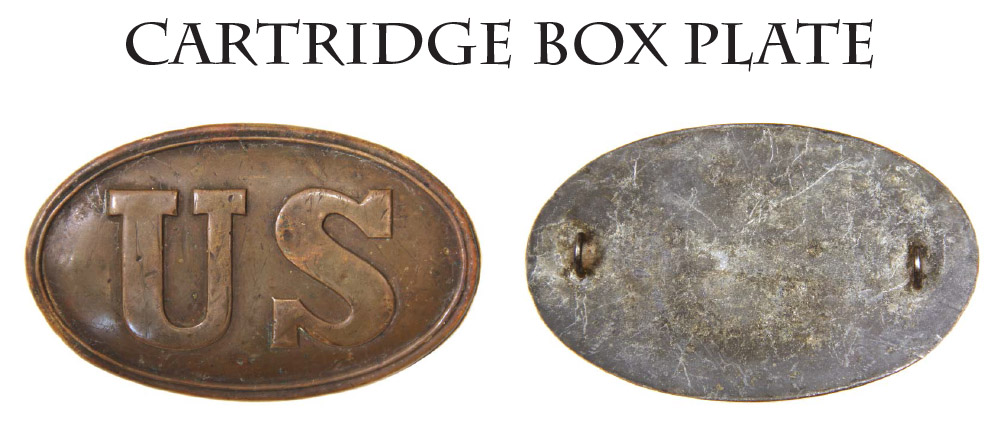
13-05-64 – Regulation Large Size Civil War US Oval Cartridge Box Plate:
I bought a few of these out of an ages old collection recently. It felt sort of like the old days finding a cache in one spot. This is the plate that was worn on the outer flap of the Union Army infantrymans cartridge box. Very good used condition as shown in the photos. Complete with both iron wire loops on the reverse side
… $195.00 SOLD
Click Here to E-mail Us!
Call us @ 419-842-1863

13-05-65 – Regulation Large Size Civil War US Oval Cartridge Box Plate:
I bought a few of these out of an ages old collection recently. It felt sort of like the old days finding a cache in one spot. This is the plate that was worn on the outer flap of the Union Army infantrymans cartridge box. Very good used condition as shown in the photos. Complete with both iron wire loops on the reverse side
… $195.00
Click Here to E-mail Us!
Call us @ 419-842-1863

13-05-66 – Regulation Large Size Civil War US Oval Cartridge Box Plate:
I bought a few of these out of an ages old collection recently. It felt sort of like the old days finding a cache in one spot. This is the plate that was worn on the outer flap of the Union Army infantrymans cartridge box. Very good used condition as shown in the photos. Complete with both iron wire loops on the reverse side
… $195.00 SOLD
Click Here to E-mail Us!
Call us @ 419-842-1863
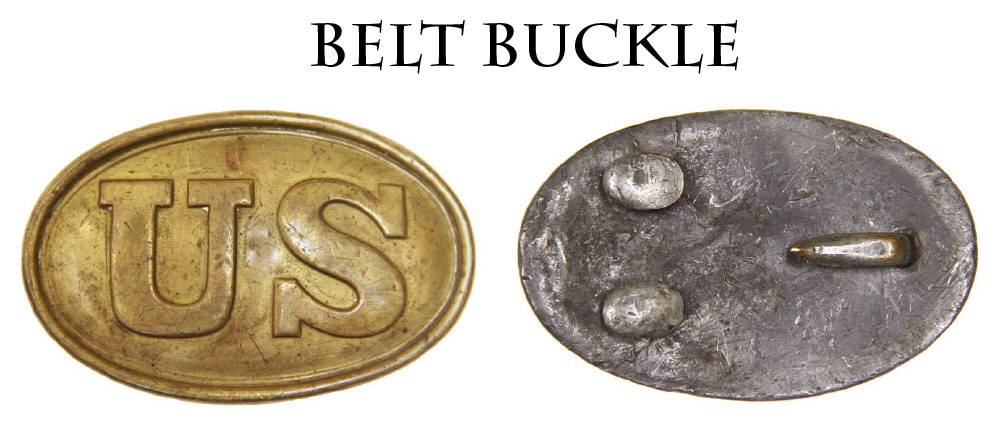
13-05-67 – Outstanding Stud Back Large Size US Oval Waist Belt Plate:
A top notch specimen of the pre-war and early war US buckle with the oval studs and single prong on the reverse. Near perfect condition. These puppy paw stud buckles were scarce when I first began collecting and always commanded a premium. Super example
… $325.00 SOLD
Click Here to E-mail Us!
Call us @ 419-842-1863
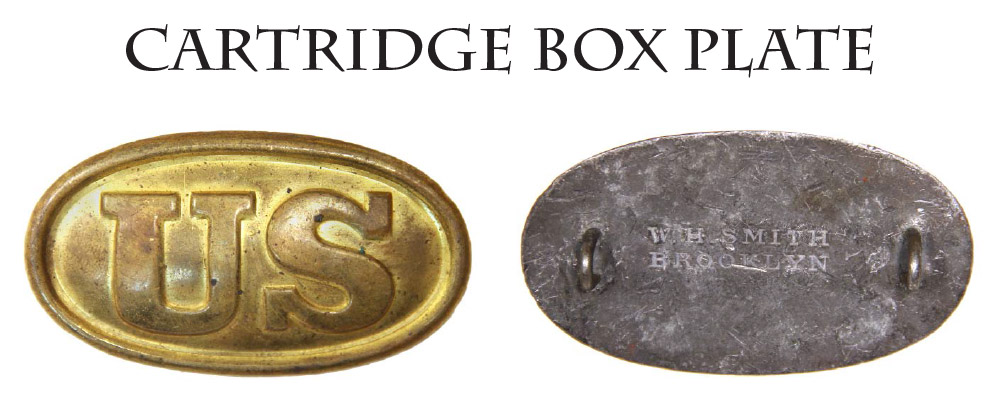
13-05-68 – Rare Maker Marked M-1839 Small Size US Oval Cartridge Box Plate:
These small size US plates have always been scarce, about fifty times rarer than the standard large size oval plates of the same time period. They came out prior to the Mexican War and were used up through the Civil War. Roughly half the size of a standard CW US plate. This plate has both iron wire loops intact in the lead backing and is stamped with the makers mark of W H SMITH / BROOKLYN Excellent non dug specimen. And very scarce with the makers mark
… $450.00 SOLD
Click Here to E-mail Us!
Call us @ 419-842-1863
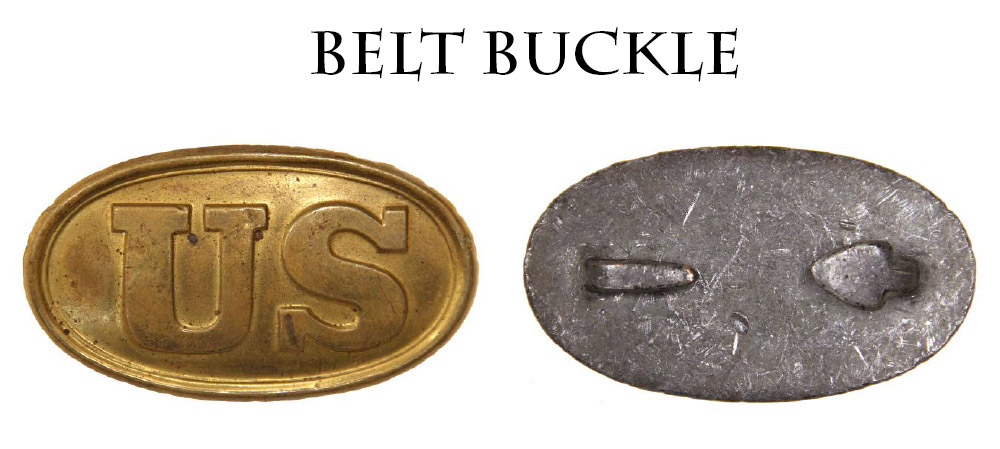
13-05-69 – M-1839 Small Size US Oval Waist Belt Plate:
These small size US buckles have always been scarce. They came out prior to the Mexican War and were used up through the Civil War. Roughly half the size of a standard buckle these have just one arrow hook and one prong on the reverse.
Excellent non dug specimen
… $365.00
Click Here to E-mail Us!
Call us @ 419-842-1863
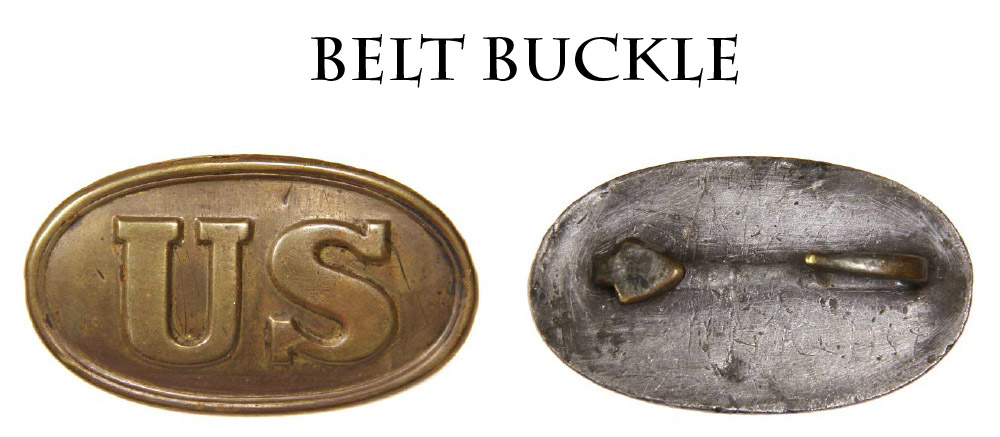
13-05-70 – M-1839 Small Size US Oval Waist Belt Plate:
These small size US buckles have always been scarce. They came out prior to the Mexican War and were used up through the Civil War. Roughly half the size of a standard buckle these have just one arrow hook and one prong on the reverse.
Excellent non dug specimen
… $365.00 SOLD
Click Here to E-mail Us!
Call us @ 419-842-1863

13-05-71 – Civil War Eagle Shoulder Belt Plate aka Eagle Breastplate:
Fine non dug example just as brought home by the soldier. These circular eagle plates were worn on the shoulder straps of the cartridge box smack dab in the middle of the soldiers chest. Legend says some Yanks threw them away as they made too good a target for Johnny Reb to pin point their hearts. As far as I can tell that story is BS folk lore. Great looking front, bent loops.
Great example of a most handsome plate
… $199.00 SOLD
Click Here to E-mail Us!
Call us @ 419-842-1863

13-05-72 – Civil War Eagle Shoulder Belt Plate aka Eagle Breastplate:
Fine non dug example just as brought home by the soldier. These circular eagle plates were worn on the shoulder straps of the cartridge box smack dab in the middle of the soldiers chest. Legend says some Yanks threw them away as they made too good a target for Johnny Reb to pin point their hearts. As far as I can tell that story is BS folk lore. Small ding on the front, with nice unbent loops. Great example of a most handsome plate
… $199.00 SOLD
Click Here to E-mail Us!
Call us @ 419-842-1863
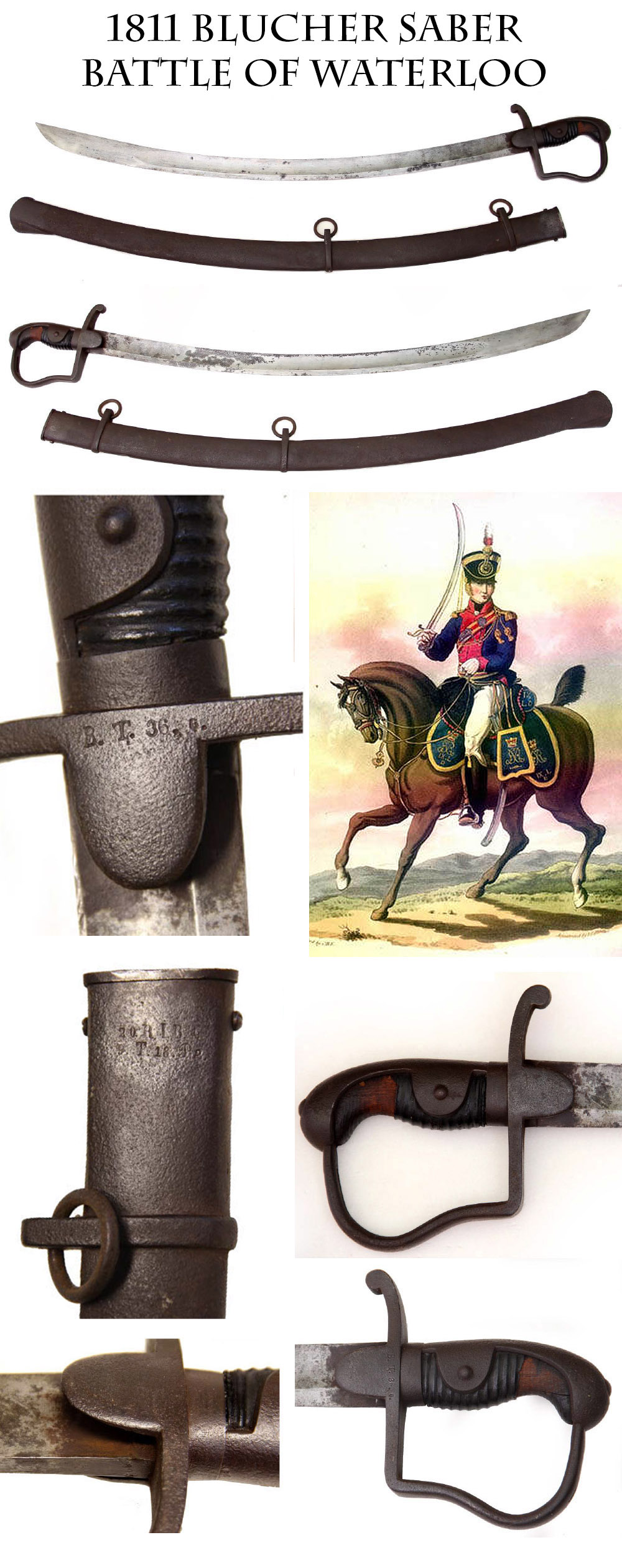
13-05-73 – Impressive Prussian Model 1811 Blucher Waterloo Era Cavalry Saber.
This heavy bladed cavalry saber with an iron P-guard hilt was a standard design for light cavalry in the Napoleonic era and made a fearsome cutting weapon. It was widely used by the Prussian Cavalry under the command of General Gebhard Leberecht von Blecher in the Battle of Waterloo. They may have been used in the American War of 1812 as well. The British version from which this was copied was the 1796 pattern; this Prussian version is more substantial and takes its name from the famous German general. Wide blade with a single wide fuller, mostly bright mixed with gray but with some darker cloudy areas on the outboard side about 1/3 along the blade and at the back edge. Iron guard with langets and backstrap with ears, leather wrapped grooved grip, no wire, about 2/3 leather still there, wood exposed near pommel. Heavy iron scabbard with drag, carrying rings and throat, showing brown overall. Light salt and peppering overall to the iron, but not unsightly. German regimental markings at top of scabbard and on guard. Some research may prove (or disprove) an actual association with Waterloo. As is nearly always the case the numbers on sword and scabbard do not match- these swords and scabbards were kept in service for decades and used by Reserve units later. Keeping the scabbards together was apparently never a concern with the Germanic Armies. A great early weapon … 200 years old
… $675.00
Click Here to E-mail Us!
Call us @ 419-842-1863

13-05-74 – US 1850 Pattern Staff and Field Officers Sword with Unusual Scabbard.
This is the 1850 pattern officers sword incorporating the U.S. in the guard design and intended for officers of staff and those ranking Major and above. Since these officers were mounted, their swords were to have sturdier metal scabbards. The blade on this is about fine with much original frosty factory luster. Has lovely etching of the standard vines and scrolls mixed with a US on one side and a nice spread winged eagle on the other holding a ribband inscribed E Pluribus Unum in its beak. The blade has some scattered gray spots near the tip. Sharkskin and wire grip is tight and complete Brass guard, pommel and knucklebow show a mellow patina mixed with generous amounts of the original gilding. Leather bumper pad in place below guard. Nice engraving on pommel edge. The sword is unsigned by maker. The scabbard follows regulations in being blued steel with brass mounts, and has very simple brass ring mounts, a narrow brass throat secured by screws top and bottom and a leaf shaped brass drag. Very handsome. Scabbard metal is smooth overall, blue faded to an even bluish-gray. A very solid and affordable example of this desirable sword
… $1,450.00 SOLD
Click Here to E-mail Us!
Call us @ 419-842-1863
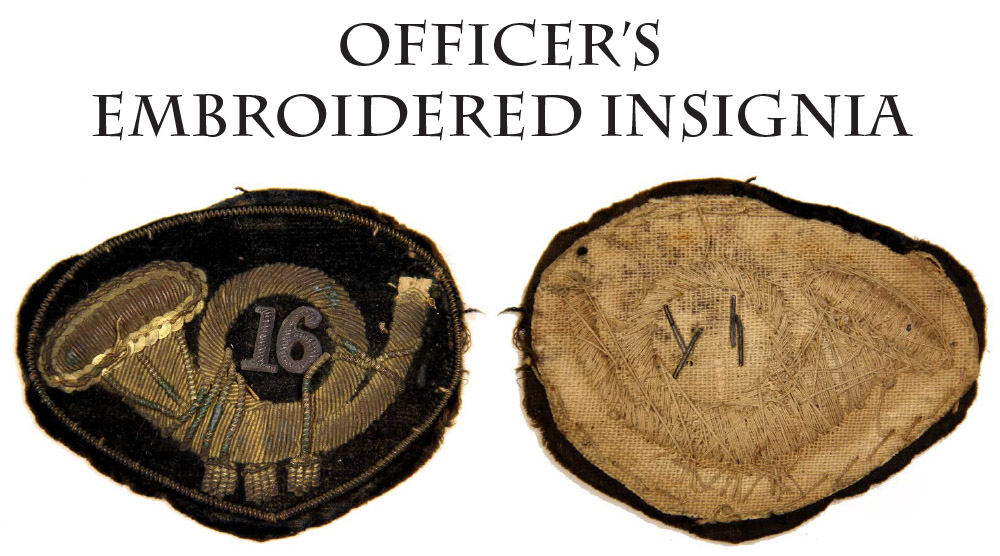
13-05-75 – Officers Infantry Hat Insignia:
Well worn but really cool large size kepi or slouch hat insignia measuring a nice large 3 inches across. Nice velvet body. Raw back. A couple pieces of bullion could be stitched down but really neat
… $435.00 SOLD
Click Here to E-mail Us!
Call us @ 419-842-1863

13-05-77 – Import Heavy Cavalry Saber & IW Hanger:
A solid and worn example of the import wristbreaker cavalry saber. All original and complete except twisted wire has been replaced. Scabbard has a few dents. Has an Indian War Jeb Stuart style saber hanger attached
… $495.00 SOLD
Click Here to E-mail Us!
Call us @ 419-842-1863

13-05-78 – 137th New York 12th-20th Corps Badge:
Fresh from the estate of legendary local collector of everything who died recently in his ninth decade of life. Not the rarest military item from his collection, but the first offered to me by the executor of the estate. Small silver star made from a coin nicely engraved on the front Co. F 137th Regiment. Shown next to a Civil War penny token for size reference. This is the 137th New York Infantry. Here is their history taken from The Union Army Cols., David Ireland, Koert S. Van Voorhes; … recruited in the counties of Tompkins, Tioga and Broome … organized at Binghamton, mustered into the U. S. service for three years on Sept. 25-26, 1862. It left on the 27th, 1,007 strong, for Harper’s Ferry assigned to the 3d brigade, 2nd (Geary’s) division, the “White Star” division 12th corps, to which it was attached throughout the whole period of its active service. … Chancellorsville, Gettysburg, Wauhatchie, Missionary Ridge, Lookout Mountain, Ringgold, Rocky Face ridge, Resaca, Cassville, Lost mountain, Kennesaw mountain, Peachtree creek, the siege of Atlanta, … the march to the sea and in the campaign of the Carolinas … “It won special honors at Gettysburg, then in Greene’s brigade, which, alone and unassisted, held Culp’s hill during a critical period of that battle against a desperate attack of vastly superior force. The casualties in the 137th at Gettysburg exceeded those of any other regiment in the corps, amounting to 40 killed, 87 wounded and 10 missing. The gallant defense of Culp’s hill by Greene’s brigade, and the terrible execution inflicted by its musketry on the assaulting column of the enemy, form one of the most noteworthy incidents of the war. The 12th corps left Virginia in Sept., 1863, and went to Tennessee, joining Grant’s army at Chattanooga. In the month following their arrival the regiment was engaged in the midnight battle at Wauhatchie, where it lost 15 killed and 75 wounded; and, a few weeks later, fought with Hooker at Lookout mountain in the famous ‘battle above the clouds;’ casualties in that battle, 6 killed and 32 wounded. In April, 1864, the corps number was changed to the 20th, Gen. Hooker being placed in command. A large accession was received from the nth corps, but Col. Ireland and Gen. Geary retained their respective commands. The 137th shared in all the marches and battles of the Atlanta campaign, and then marched with Sherman to the sea.” … When the campaign of the Carolinas closed with the surrender of Johnston, the regiment marched with the corps to Washington, where it participated in the grand review and was mustered out June 9, 1865 6 officers and 121 men, were killed and mortally wounded … 4 officers and 167 men died of disease, accidents, and all other causes, a total of 294. The total number of killed and wounded was 490. END. A fine little silver corps badge that hasnt seen the light of day in decades. Pin on back gone but T-bar hinge and catch are still intact. Interestingly while researching this badge on the net I found a metal detector page www.treasurenet.com forum where a relic hunter calling himself Woodland Detectors shows a 12th 20th Badge he dug up in a 20th Corps Camp that is IDENTICAL to our badge except the face is not inscribed. I telephoned Woodland Detectors and spoke with the owner who told me he dug his badge in North Carolina and sold it to a collector in Texas for just under a thousand dollars. I will sell this for
… $750.00 SOLD
Click Here to E-mail Us!
Call us @ 419-842-1863

13-05-79 – US 1861 Pattern Rifle Musket dated 1863 produced by Burt and Hodge at the Trenton Locomotive and Machine Company.
A.M. Burt and J.T. Hodge were partners in leasing the Trenton facility to produce rifle muskets for the US government on contracts taken in each of their names. This is a nice example with Burts name stamped on the left side of the stock near the inspector cartouche. Crisp 1863 date rear of lock, eagle and U.S. / Trenton forward. Matching nice 1863 barrel date, crisp V/P/eagle proofs left barrel flat. Metal is smooth overall, fading bright in color with some gray clouds on the lockplate and some mottling to the hammer. Rear sight shows traces of original blue. Barrel generally bright with some scattered gray. Area around bolster is very good, screw slots good. Slight vise marks near sight. Wood edges slightly rounded from handling. Good wood-to-metal fit. Some losses at forward edge of lockplate. Bands, springs, rod, swivels, etc., all correct and in place. Very pleasing overall, a key piece in the history of Civil War arms, and a good example of a midwar contract rifle that soldiers were glad to have in place of the early war European fence rails they had had been trying to kill each other with up till then. This is a very good example of the typical Civil War infantrymans regulation issue weapon and would display like gangbusters with a good belt set and cartridge box rig.
It shows all the signs of really being there … Super fair price
… $1,395.00 SOLD
Click Here to E-mail Us!
Call us @ 419-842-1863
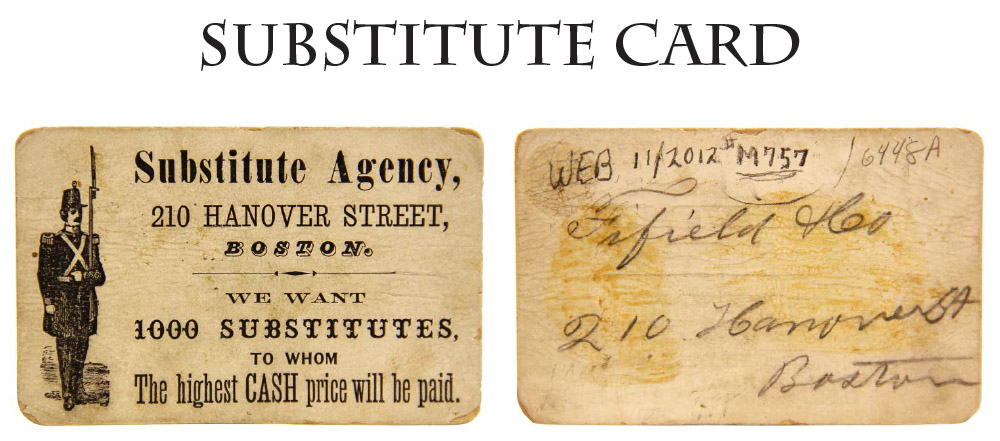
13-05-80 –
The last trinket I bought from Norm Flayderman two weeks ago.
Click Here to E-mail Us!
Call us @ 419-842-1863

13-05-81 – French Model 1853 Lefaucheux Pinfire Cavalry Revolver
– This is the Cavalry model with a 12mm bore (slightly larger than 45 caliber) utilizing the long obsolete pin-fire cartridge. The LeFaucheux was one of the only foreign-manufactured revolvers to have been imported by the U.S. government during the Civil War. At the outbreak of war in 1861, both the Federal and Confederate governments looked to Europe to supplement insufficient arms inventories, and approximately 14,000 Lefaucheux revolvers were purchased at a cost ranging from $12.50 to $20.04 each. Of these, 12,000 found their way into Union service with known serial numbers in the 25,000 to 37,000 range. The serial number in this revolver is #34109 which places it in the proper range for war usage and smack dab in the Missouri Cavalry range. Condition is Very Good with a couple hints of case and blue in areas. Lacks the lanyard in the butt otherwise complete. The grips are VG+. The gun has the true Lefaucheux firm markings Much better condition than most we see
… $950.00 SOLD
Click Here to E-mail Us!
Call us @ 419-842-1863
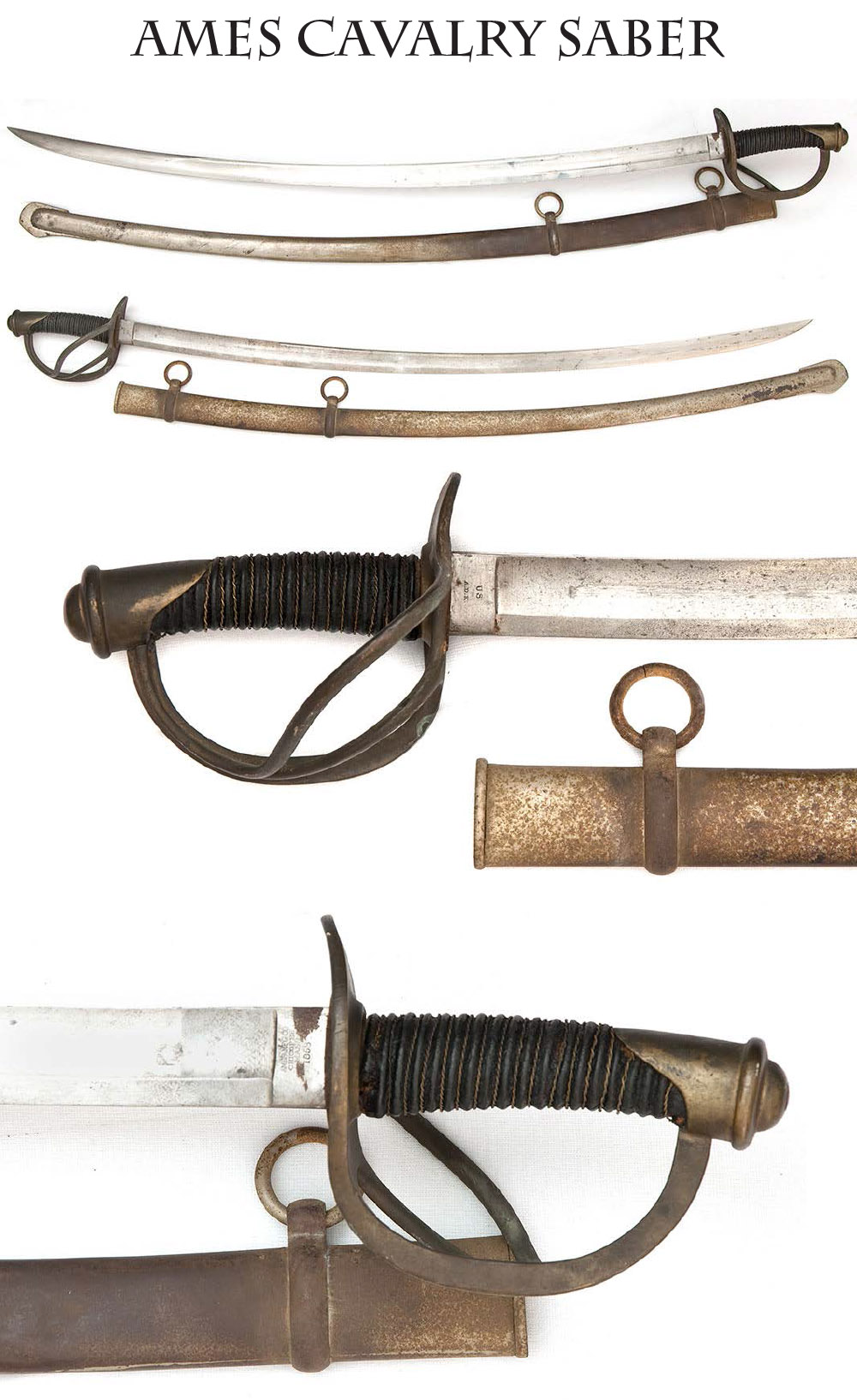
13-05-82 – Ames model 1840 Heavy Cavalry Saber –
35 1/2 blade is marked US ADK and the reverse side with date stamp of 1859 and full Ames firm marking. The condition is about very good with nice shiny blade and no edge nicks, scabbard with no dents and showing evidence of plating for parade purposes. Handle wrap quite worn with some loss of leather and replaced twisted wire wrap. Fine brass guard. This is the wristbreaker with heavier blade and flat spine that preceded the standard 1860 Light Cavalry saber. Dirt Cheap
… $650.00
Click Here to E-mail Us!
Call us @ 419-842-1863

13-05-83 – Regulation Civil War U.S. Issue Tarred Haversack in good, well used, condition!
These have never been easy to find, they were rare in the 1950s! An essential piece of soldiers gear, they were so useful that after the war the vets kept using them as game bags, rucksacks and lunch bags. While stacks of knapsacks were still available as war surplus until recent years, haversacks were not available as surplus much after 1920. They were always scarce. This is the US regulation issue pattern. A simple tarred canvas bag with a wide tarred canvas shoulder strap stitched at the top rear corners of the bag. This one retains the three original tinned iron buttons on the interior which secured a removable liner. The closure strap is intact, the buckle strap is missing. The tarred canvas shoulder strap has no tears and the body of the bag is solid, with a separation tear along the top fold on the flap. I had helper Tom repair the flap using a combination of thin leather and some original tarred canvas from a relic CW knapsack. One side of the strap was pulling away from the rear of the bag and Tom fixed this as well. There are some nicks, tears, and pulls along both side seams of the bag but nothing of consequence and I have elected to leave those alone. This is a key piece of equipment for any Civil War display or collection. Men from every branch of service were issued these to carry food and mess gear. They are a great piece for a camp or combat display. Men frequently discarded knapsacks on the march or when going into battle, but they kept canteens and haversacks with them always. A true rarity in Union Army equipment
… $1,250.00 SOLD
Click Here to E-mail Us!
Call us @ 419-842-1863
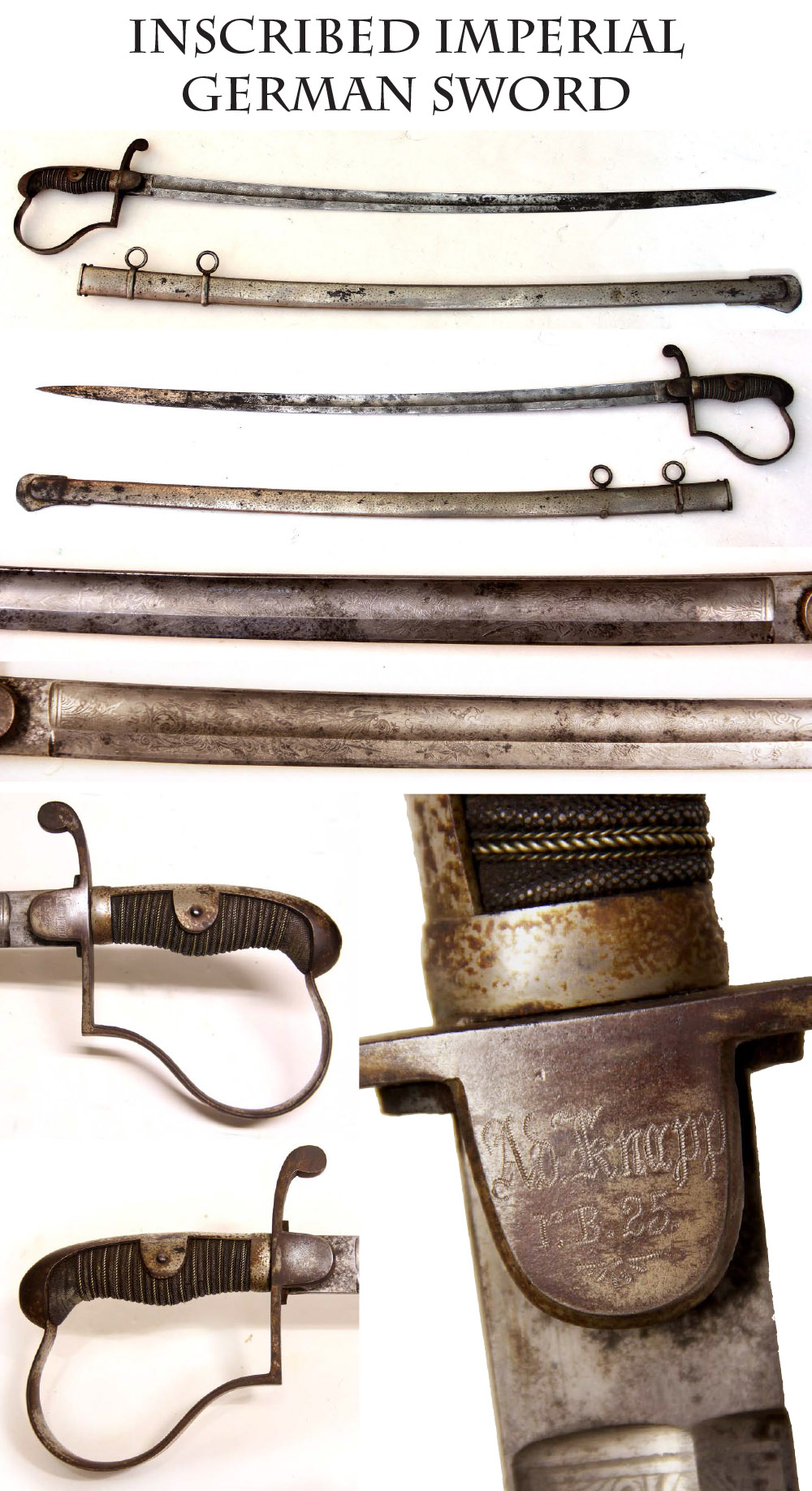
13-05-84 – Inscribed Imperial German Officers Sword:
From the period of the Franco Prussian War is this inscribed Prussian sword. Langet inscribed Ad. Knapp R.B. 25 Blade nicely etched. Handle worn but solid. Ill let you do the research. A lot of sword for a little bit of money
… $395.00
Click Here to E-mail Us!
Call us @ 419-842-1863
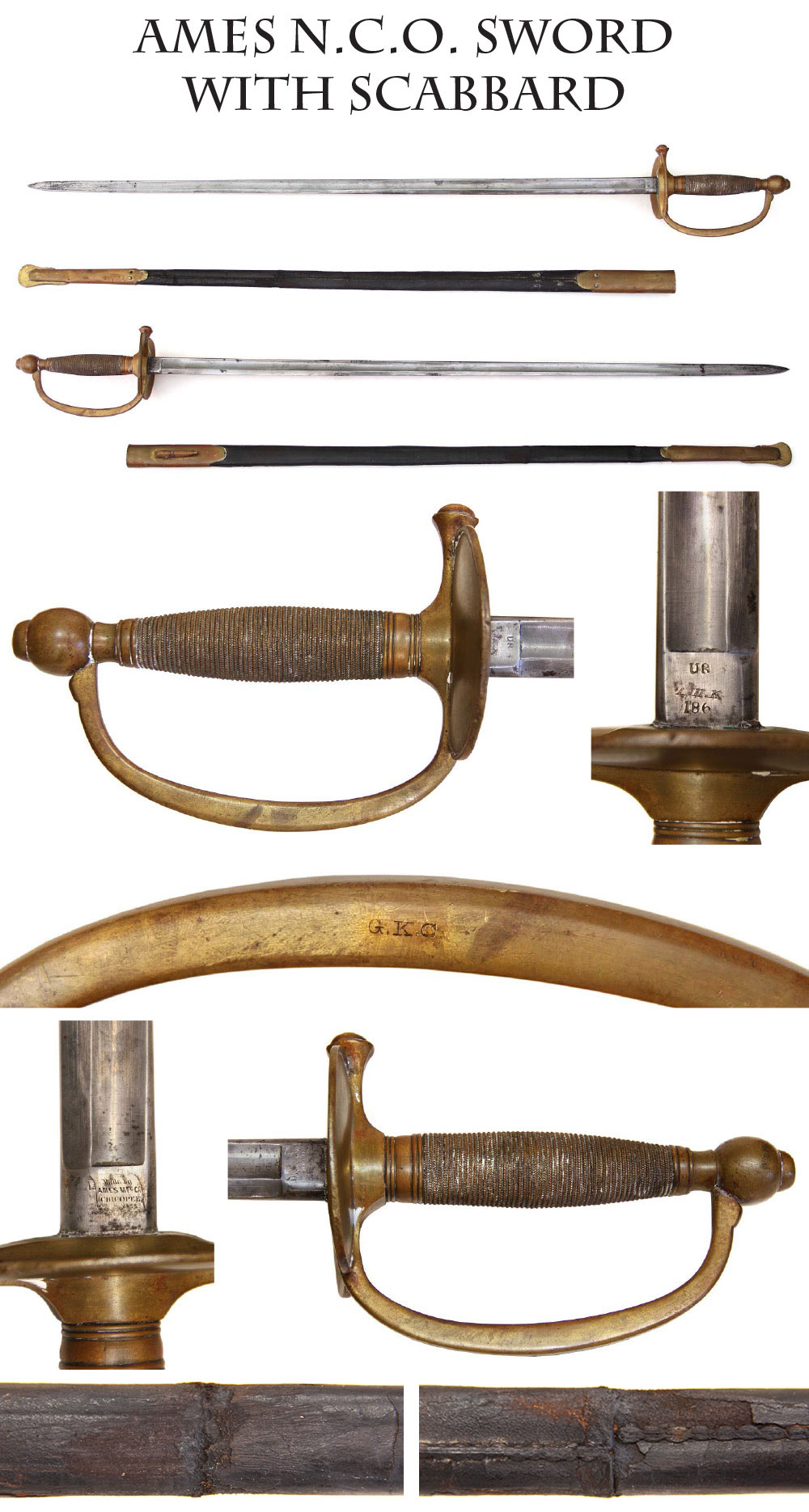
13-05-86 – Ames Civil War NCO Sword and Scabbard:
Regulation m1840 US Non Commissioned Officers sword made and marked by Ames Mfg. Co. and dated 186? with full inspectors marks. (The last digit of the date appears to have not been struck, or was struck so light as to not be legible.) Sword is VG to Fine condition. Blade excellent. The scabbard is the original and proper brass mounted leather type. When we found this it had a break in the leather scabbard and some loss above the drag. The original drag was still present. I had helper Tom repair this using a small section of original leather NCO sheath that I had saved from another example. He did a great repair. Beautiful patina on all the brass.
This is the sword carried by corporals and sergeants in the Union Infantry
… $435.00
Click Here to E-mail Us!
Call us @ 419-842-1863
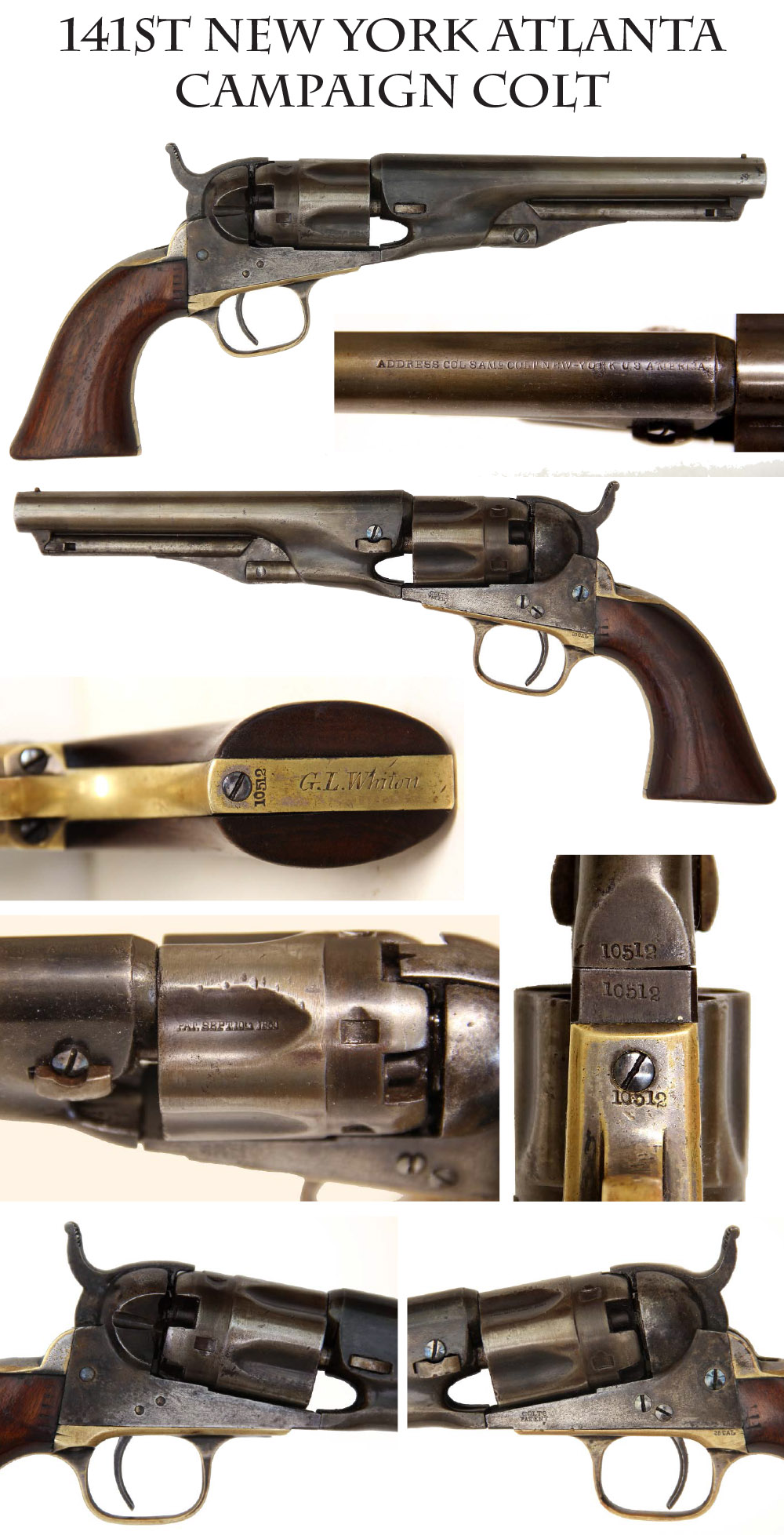
13-05-87 – Inscribed Colt 1862 Police 141st New York…
Great Condition and History! Excellent condition Colt .36 Caliber Police Pistol identified to a very active officer. This is a nice looking gun in and of itself: showing faded case colors on the frame, some bright blue on screw heads and traces of blue on the barrel just forward of the cylinder, the rest of the barrel evening out into a smooth, pale faint brown I like to call nicotine; Some scattered dark areas on the rammer assembly, hammer and back of the frame, but no roughness or pitting, traces of silver on brass backstrap, tight wood with sharp Colt markings on barrel and patent markings on cylinder and frame: matching serial #10512 throughout. Very good grips, tight wood, five small hash marks where they join the frame on one side and two on the other, very lightly done and I dont know the significance. Has a fine professionally engraved inscription on the butt: G.L. Whiton. Only two federals named G.L. Whiton show up: a private with no middle initial in an Ohio cavalry unit who died in February, 1862, and was dead before he could have acquired this gun. Our man is – George L. Whiton, who enlisted at age 29 in Elmira, NY, as a First Lieutenant on 9/10/62,, and was commissioned into company K 9/11/62. He was transferred to Co. F 8/18/63, and then back to Company F as Captain 7/30/63, and discharged at the end of the war on 6/8/65 and breveted Major for his service.
This is just the sort of light but effective pistol an infantry officer liked to have. Forget about reenactor officers marching around with .44 Colts and Remington Armies dragging their belts down to their feet. And given all the marching and fighting Whiton did, he was probably glad for the selection he made. The 141st served in the 22nd Corps and then the 7th and 4th, seeing its first action in the siege of Suffolk, Va, in the Spring of 1863. It joined the 11th Corps in the Army of the Potomac in July, 1863, and went west with them in September
…More data coming… Call for price
Click Here to E-mail Us!
Call us @ 419-842-1863

13-05-88 – Rare Original Flint 1817 Pattern US Common Rifle by Deringer!
These dont come along in original flint very often, and less frequently in this kind of condition, which rates near fine. An essential piece for the US martial arms. These were produced for the government over a number of years starting in 1817 and were unusual in being made only by government contractors, not at the national arsenals, who were busy turning out M1816 muskets. These are a sturdy and substantial rifle. Used in the early westward expansion of the country, many were converted to percussion and were still in service in militia hands at the beginning of the Civil War.
Very clean wood with very good edges around the lock plate and offside. A minor ding below and to the rear of the lock, and thats bout it, just minor handling marks. Vivid cartouches on the stock, metal in the bright overall with just the usual mellow fading to silver with some gray spots here and there. Sharp 1843 lock date and maker marks on the plate, matching barrel date on the breechplug tang, nice US/JH/P proofs on the barrel at breech. Mechanics are perfect. Ram rod is an incorrect replacement otherwise 100% original and complete.
A very well cared for gun. Has a light E.L. carved inside the patchbox. Whoever he was, he took care of this.
A key weapon in the history of the US rifle in excellent condition, and one you dont have to take a magnifying glass to the touch-hole to tell it has never been monkeyed with. A rare gun in original flint
… $3850.00 SOLD
Click Here to E-mail Us!
Call us @ 419-842-1863
Layaways are Welcome
Need to split your order into multiple payments? No problem! A simple 20% earnest money deposit will hold your item for you.-acf
You can then pay it off in easy installments that fit your budget.
Read Terms Here
Items to Sell? Contact Us
I am always interested in buying ANYTHING from the American Civil War… Guns, Swords, Civil War Muskets, Knives, Uniforms, Flags, Medals, Badges, Diaries, Letters, Autographs, Buttons, photographs, tintypes, daguerreotypes, Insignia, Camp Items, Battlefield Relics, canteens, Drums, Etc… Call 419-842-1863 and ask for Dave Taylor.

